DMZ JSA tour
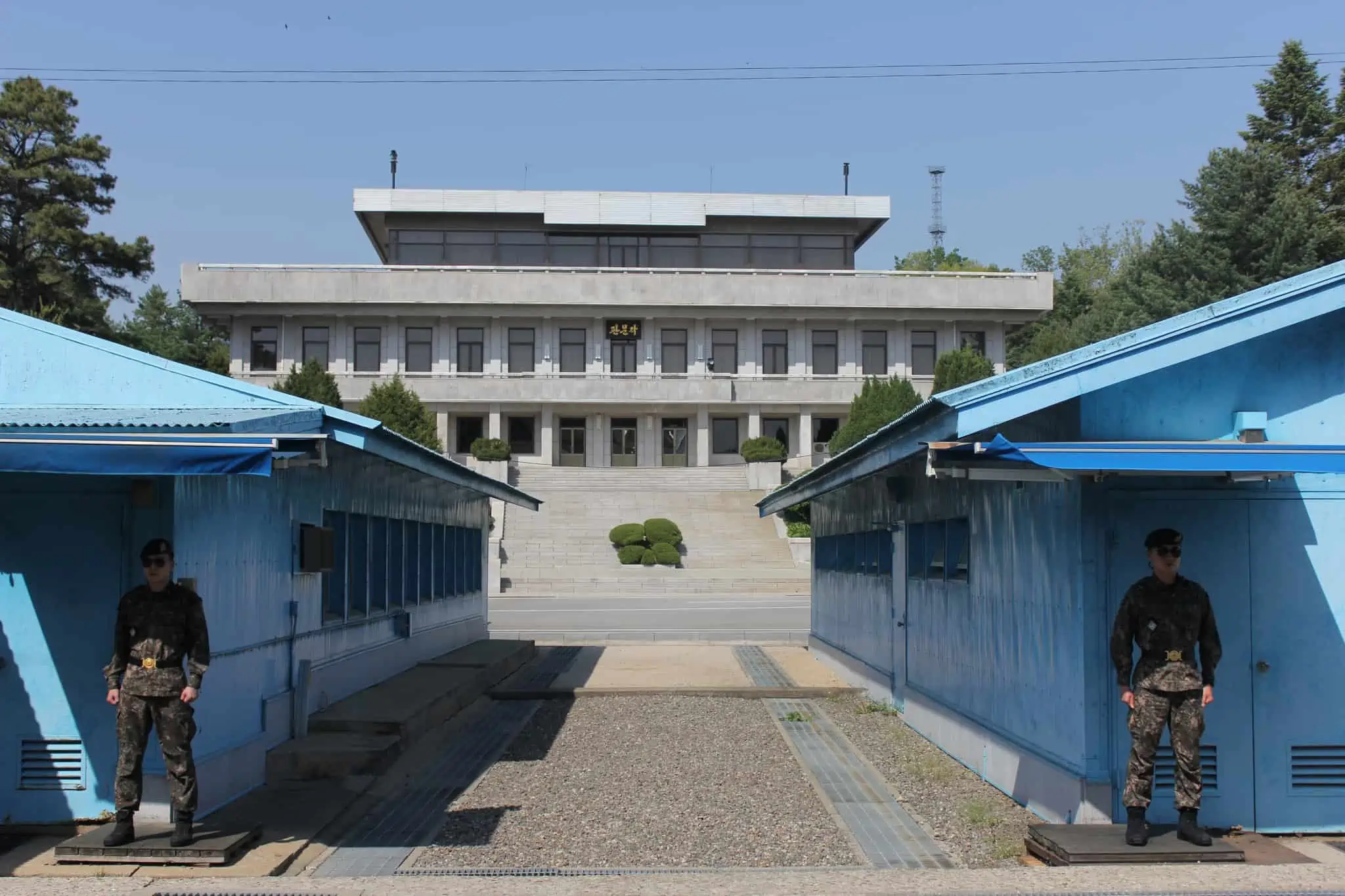
Experience the mystery of the Korean Demilitarized Zone and the unique Joint Security Area! These sights should be at the top of every adventurous traveller’s bucket list. No other country in the world has such a remarkable historical division and simultaneous desire for peace. Create unforgettable moments and get insider cultural knowledge on our DMZ JSA tour!
* JSA tour bookings need to be made at least 7 days before your tour. * Children under 12 years old are not permitted to join this tour.
- Description
- Reviews (6)

What is the DMZ – Demilitarized Zone
The DMZ is the area surrounding the Demarcation Line (DML), which separates North and South Korea. About a half-century ago, the DML was drawn to keep the two countries physically separated.
This border came about from the need for peace between the two countries after the prolonged military and political tension. The DMZ is 250 kilometres long with a four-kilometre diameter.
North Korea is famous for being mysterious and very hard to visit. Our DMZ tours will allow you to get as close to the infamous country as possible and even look across the border!
What is the JSA – Joint Security Area
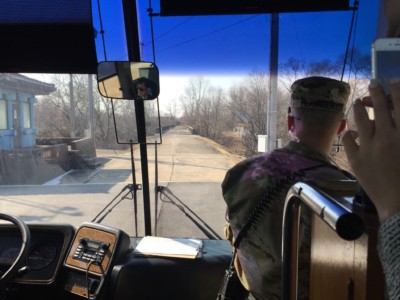
The JSA (Joint Security Area) is a shared space between North and South Korea. Here the two countries can coexist with the help of the United Nations Command Military Armistice Commission (UNCMAC). This is the only place where South and North Korean forces stand face to face – a sight not to be missed!
The former village (Panmunjeom) sits just 60 kilometres northwest of Seoul and was initially called “Neolmun-ri.” The area is rectangular, with a size of 400×800 meters and is set up on the Military Demarcation Line, essentially making it neutral ground.
Here, you will find various buildings that accommodate negotiation talks and a few bridges of great historical importance.
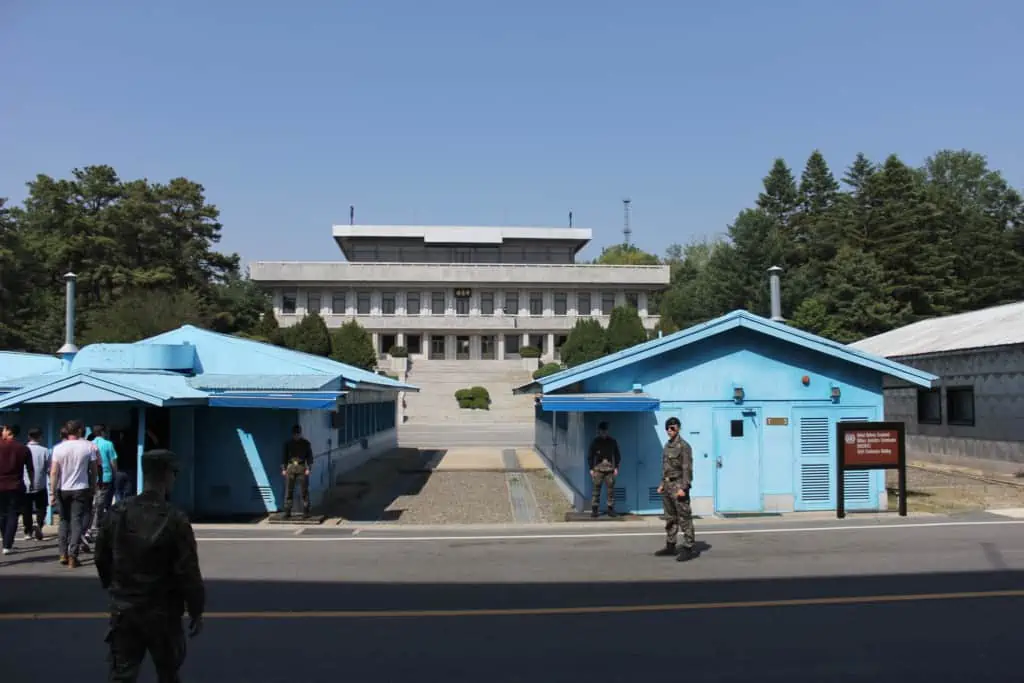
Don’t miss this chance to see one of the unique corners of the world! Our DMZ JSA tour from Seoul is one of Korea’s most popular and loved tours, and we make sure that you see all these incredible landmarks in comfort.
JSA tour Regulations and Restrictions
The JSA is a unique area due to its purpose – to preserve peace, and therefore the United Nations Command (UNC) have some strict regulations to bear in mind.
Everyone wishing to visit must supply their passport and register at least 7 days in advance. We, therefore, request a full-colour copy of your passport page when booking. All members of your group should be at least 12 years old, and those younger than 18 must be accompanied by a parent or guardian.
In addition, the UNC limits the number of people that can visit daily. This limit means it can get booked up very quickly.
If you wish to avoid the restrictions and ensure there is enough space, we suggest you book our DMZ Half Day Tour . This way, you will still see everything there is to see at the DMZ but will not have to deal with pre-registration and limitations.
What to expect on our DMZ JSA tour – key features
Our tour has a very well-organized itinerary that makes sure you don’t miss a beat and are as comfortable as possible. Our pickup and drop-off location is City Hall Subway Station (Exit 6), a central and easily accessible location in Seoul to start and end the day.
We provide professional, licensed tour guides who will be there from start to finish to answer all of your questions. All transportation is included and we take care of all the entrance fees for you, so you don’t have to worry about the details!
One of the key features not to be missed on our DMZ JSA tour is looking into North Korea. You can get a very clear view across the border when the weather is good!
In addition, we will walk through the 3rd Infiltration Tunnel dug by North Koreans in an attempt to attack the South. Don’t miss this chance to walk in the steps of the soldiers! The tunnel has a steep slope and is two meters tall and two meters wide. If you don’t feel comfortable in confined spaces, we invite you to wait for us by the exit.
Lastly, we will visit the infamous border between North and South Korea! This is an experience you cannot get anywhere else in the world!
Charge your camera – these are our tour highlights not to miss
Since this area is so rich in history, there are a few buildings and landmarks that you can not miss! We will make sure to cover them all on our tour. Here are all the details you need to know about these spots in advance.
Imjingak – a spiritual place for mourning
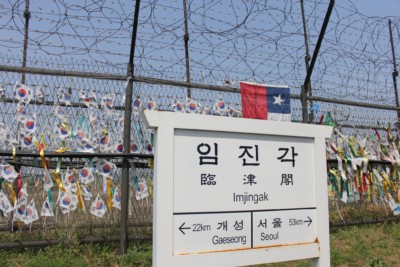
Sitting 53 kilometres northwest of Seoul, Imjingak is where South Koreans come to mourn their lost ancestors who have fallen in the Korean War.
This ritual happens on every Lunar New Year’s Day. It aims to comfort about ten million people who pay respects to their families lost in the North.
The Bridge of Freedom – crying “Hurrah!”
Until 1998, the Bridge of Freedom was the only direct link to Camp Greaves, Liberty Bell, and Panmunjeom.
According to the history books from the war period, about 13,000 captives crossed the bridge yelling “Hurrah!” for freedom, which gave this structure its name.
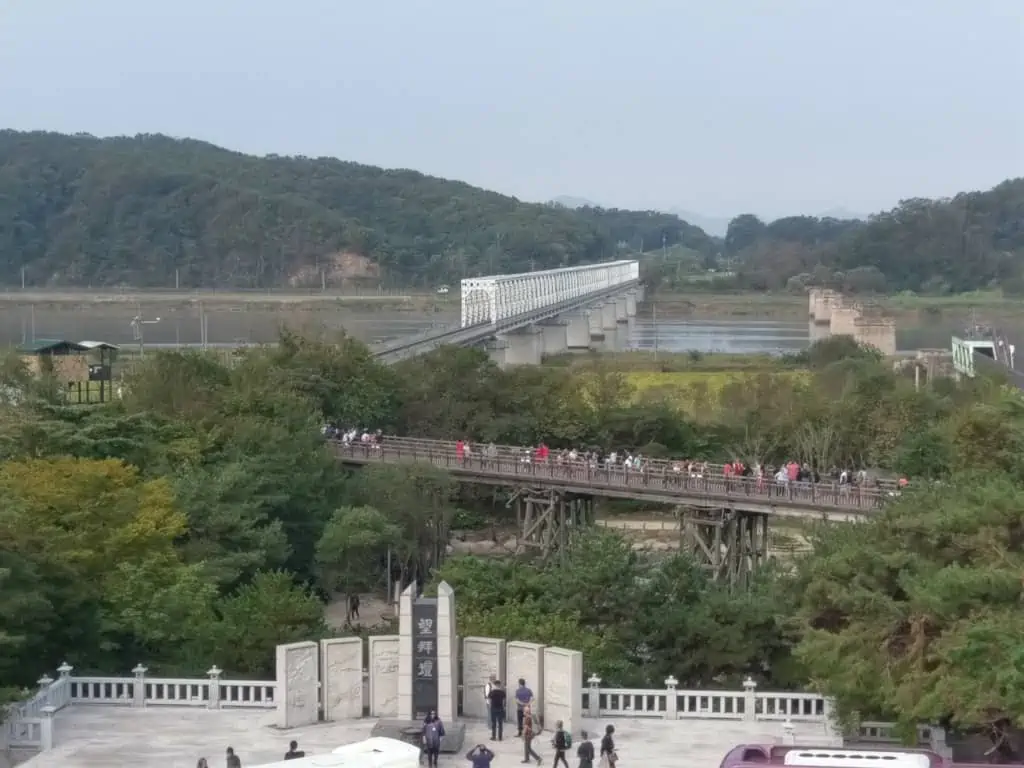
Feel the spirit of exaltation as the war has come to an end at this historic place on our DMZ JSA tour.
The Third Tunnel of Aggression – crawling through time
This hidden tunnel was discovered in October of 1978. Resembling Tunnel II, which both the North and South knew about, this one was secret! The tunnel’s location lies just 4 kilometres away from Truce Village (Panmunjeom).
The measurements of the tunnel are 1,635 kilometres long, 1.95 meters high, and 2.1 meters wide. It was made big enough to move an entire division per hour and was clearly built for a surprise attack on Seoul! So on our DMZ and JSA tour, we will have the chance to go inside and see the secret tunnel for ourselves!
DMZ Theater and Exhibition Hall – an organised look into past events
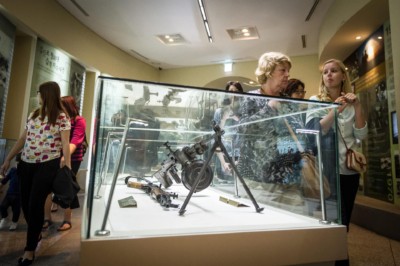
If you’d like to track the events of the Korean War and see a significant amount of evidence, you would love the DMZ Theater and Exhibition Hall. Here, you can expect to see leaflets, bayonets, military letters, pottery, and empty cartridges.
These objects will give you an idea of what life was like during this challenging period and will transport you back in time.
Dora Observatory – see across the border inside North Korea
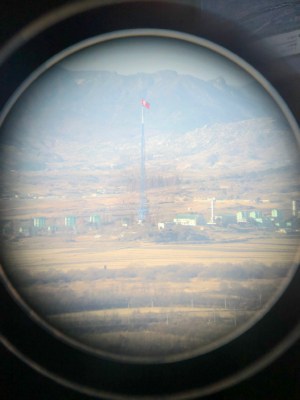
Due to stringent regulations, we aren’t allowed to go into North Korea, so instead, we make sure to get you as close as possible so you can have a look at the mysterious country! Dora Observatory is the closest point to North Korea.
Dorasan Station – the railway connecting North and South
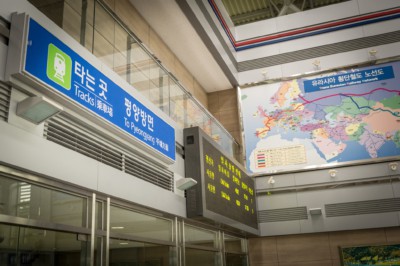
Unification Bridge – the idea of peace is manifested
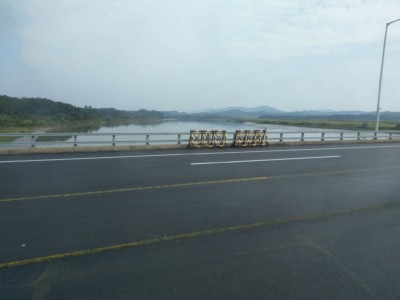
The Unification Bridge (Tongildaegyo) started as an idea of unification. It was built symbolically in 1998 by the Hyundai Business Group of South Korea and towers over the Imjingang River, which flows from North Korea.
The bridge got a peculiar nickname – “Cow Bridge.” This is because of the founder of Hyundai, Mr Jung Juyoung, who crossed the bridge going to North Korea in 1998, bringing 1001 cows.
Camp Bonifas – remembering a hero
Camp Bonifas is a military post that belongs to the United Nations. The site was previously known as “Kitty Hawk”, but on August 18, 1986, the name was changed to honour Captain Arthur G. Bonifas. The American captain was killed in the “axe murder incident”, so the camp was dedicated to him posthumously.
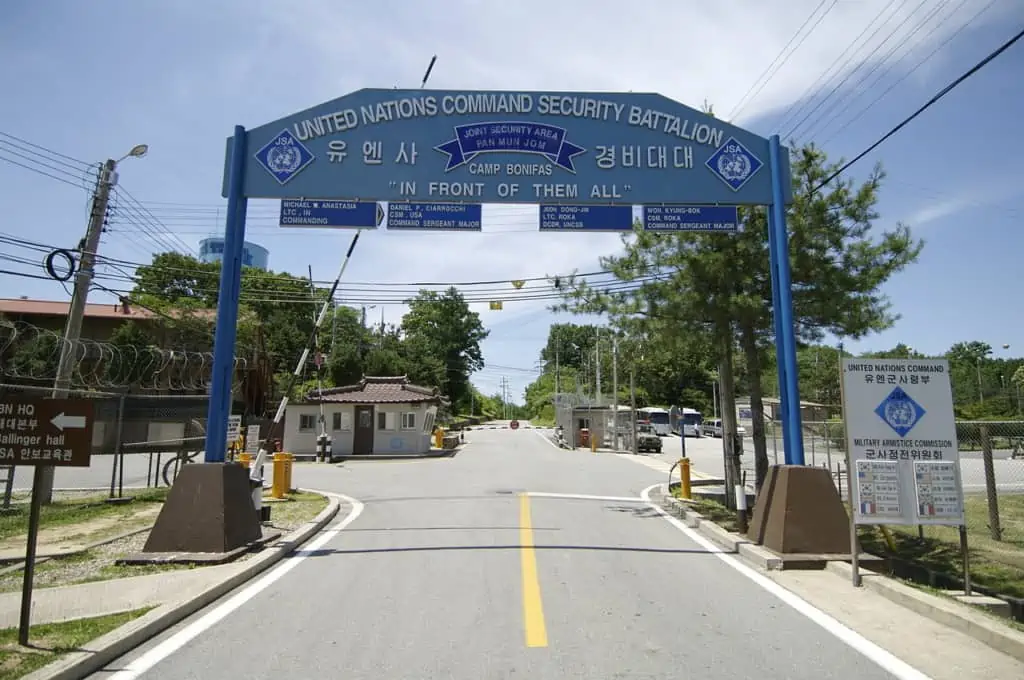
We will visit this camp during our DMZ and JSA tour. Here you will receive a briefing and watch a slide show from UN military personnel before visiting Joint Security Area.
Freedom House – a safe space for peace talks
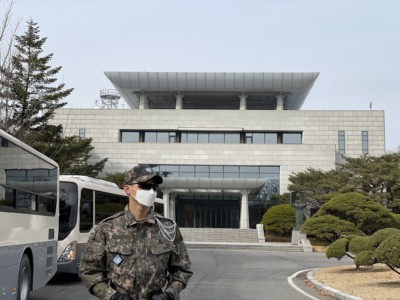
The Freedom House is located on the south side of the JSA and was finished in July of 1998. The building has a modern design and four floors. It serves as the home to the “South and North Liaison Office” and “South and North Red Cross Liaison Office.”
This space aims to provide a safe zone for discussion, inter-Korean dialogues, and cultural exchanges aimed at peace.
Military Armistice Commission Conference Room – enforcing the historic agreement
The United Nations Command Military Armistice Commission (UNCMAC) was assembled in July 1953 at the end of the Korean War. Its goal is to ensure that peace is maintained and that the Korean Armistice Agreement is strictly enforced.
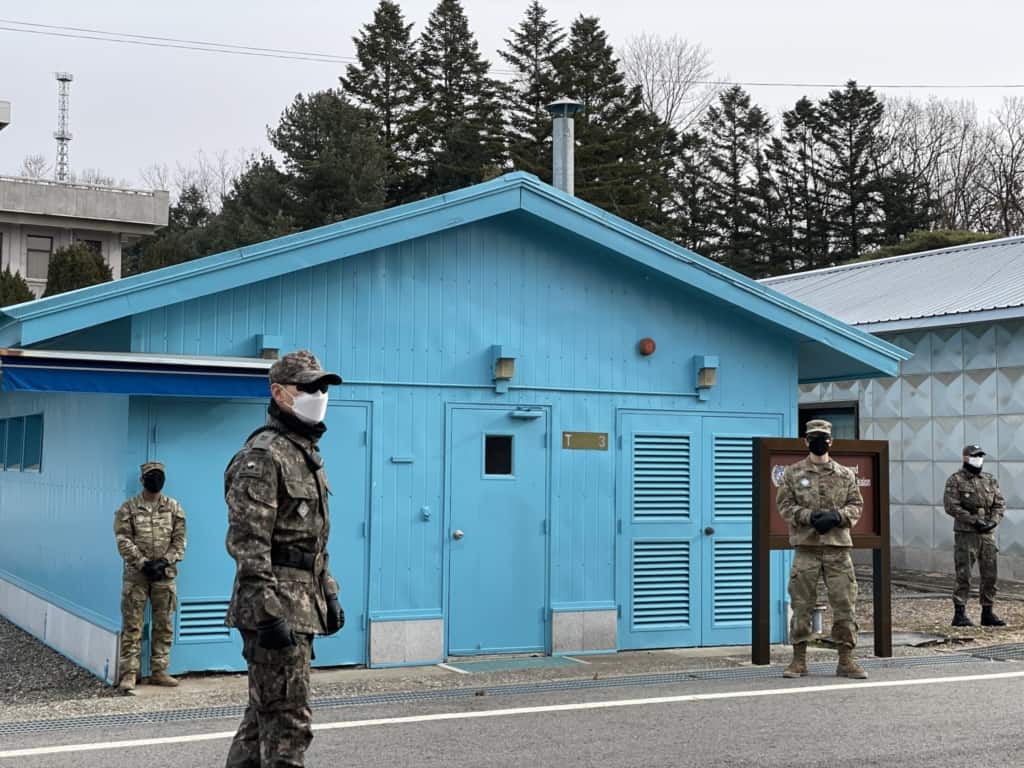
The conference room is where it meets. The North and South take turns using the conference rooms in the JSA, which have doors on both ends to ensure privacy and equal access.
Inter-Korean Peace House – leaving military matters aside
The Peace House was completed on December 19, 1969. It is used for talks that have nothing to do with the government or the military and is located 130 metres south of Freedom House.
This building was first constructed in 1980 when the two countries’ prime ministers needed a neutral place to meet and have a dialogue. It was later rebuilt in 1989 and is still used to this day.
Tongilgak (Unification Pavilion) – the hidden office
Tongilgak is a conference hall on the northern side of the JSA that has a similar function to the Peace House. It has mainly been used to house North Korea’s “South and North Liaison Office”, which has been the case since May 1992.
This is where various inter-Korean talks have taken place. Similar to the mysterious image of North Korea, this building is not easily visible. It’s located 100 meters northwest of Panmungak, and you need to actively look for it to see it!
Panmungak (Phanmun Pavilion) – a place for propaganda
Panmungak’s role in the Joint Security Area is to represent North Korea. The building was first constructed on September 2, 1969, and is where North Korean officials have their offices. The building also serves as the waiting room for UN officials who want to have a dialogue with North Korea.
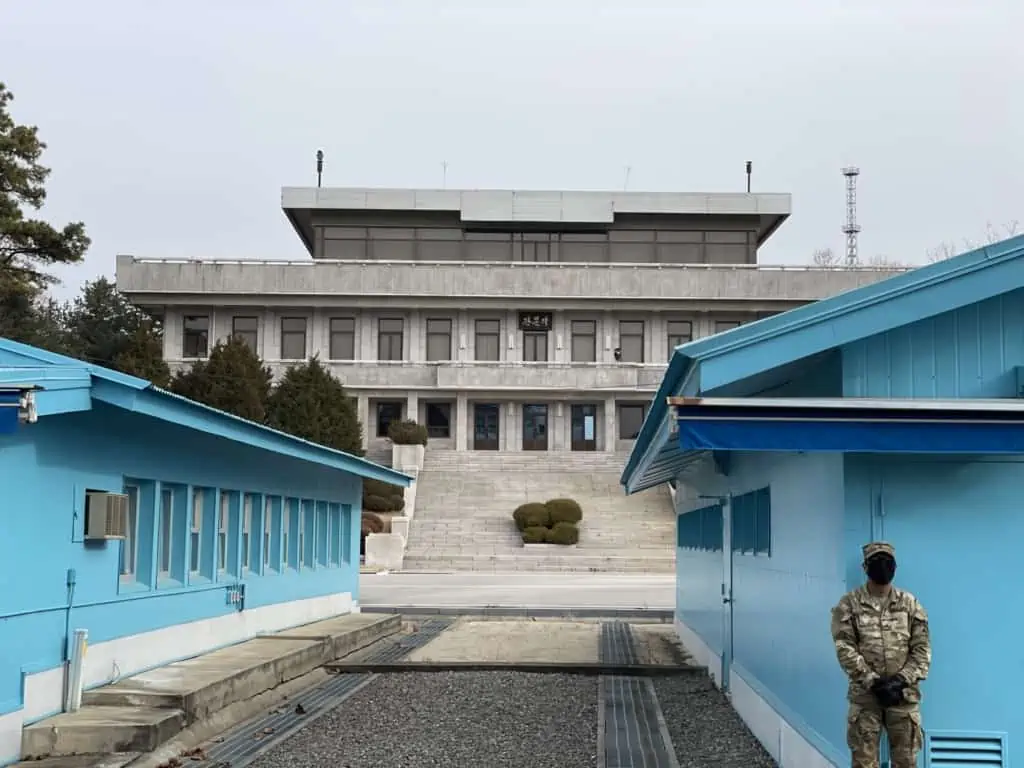
The curious fact about Panmungak is that propaganda efforts take place here. The North is famous for its efforts to promote propaganda information against South Korea. One such example is the “Pan-Korean Convention” that happens every 5th of August. Moreover, this building was completely closed off to the North Korean public until 1964.
The Bridge of No Return – a place marked by a shocking event
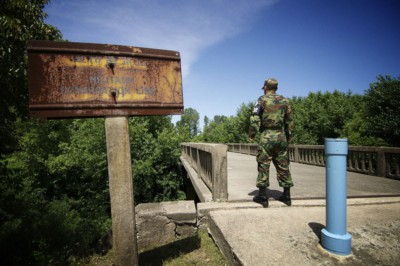
You may recognise this bridge from the popular James Bond movie “Die Another Day”. This is also the bridge where the famous “axe murder incident” happened on August 18, 1976. The bridge became infamous as the spot where General Arthur Bonifas and First Lieutenant Mark Bennett were killed.
However, the original purpose of this bridge, which gave it its name, was to be a place where POWs (prisoners of war) were exchanged. Once a prisoner chose the country he wanted to go to, there was no coming back, hence the bridge of “no return”. Don’t miss the chance to see this tense and historically rich place on our DMZ JSA tour!
The Bridge of 72 Hours – a desperate need for access by North Korea
After the “axe murder incident” happened, the Bridge of No Return was shut down and was no longer in use. That meant that North Korea lost its access to the JSA. Shocked and desperate, the government decided to build a new one.
This is how the Bridge of 72 Hours appeared. It only took 72 hours for its completion, which was a massive effort on behalf of the North. This bridge connects Panmunjeom and the city of Kaesong to the north.
As you can see, the DMZ and JSA are two places extremely rich in history and unique in their cultural aspects. Be sure not to miss the chance to discover their mysteries with our DMZ JSA tour!
DMZ + JSA tour Itinerary
- Meet at City Hall Subway Station (Exit 6)
- Bridge of Freedom
- Third Tunnel of Aggression
- DMZ Theater and Exhibition Hall
- Dora Observatory
- Pass by Unification Village
- Lunchtime at Imjingak Park
- Unification Bridge (Passport Check Point)
- Camp Bonifas (Slide Show and Briefing)
- JSA (Freedom House, Conference Room etc)
- Drop Off at City Hall Subway Station (Exit 6)
Our DMZ and JSA tour includes
- Fully licensed tour guide
- Transportation to and from the DMZ and JSA
- Entrance fees and tickets
- NO forced shopping stops
Additional Notes
- Please bring your passport on the day for UNC military checkpoints.
- A full-colour scan of your passport picture page including the bar code at the bottom should be sent to us by email at least 7 days in advance.
- Payment has to be fully arranged at least 7 days before the tour date (by credit card).
- A 100% cancellation charge will be applied when cancelling within 7 days of the tour date.
- The above itinerary, time and price can be changed depending on the current situation.
- JSA tour bookings need to be made at least 7 days before your tour .
- Korean nationals cannot join this tour.
- The following dress code applies: Normal blue jeans are OK to wear, but no sleeveless shirts, t-shirts without the collar, short pants, skirts, sandals, military-looking clothes, or clothing with a country flag or name of the nationality on it.
- Children under 12 years old are not permitted to join this tour.
- The JSA is controlled by the United Nations Command (UNC), so there are limited seats due to restrictions.
6 reviews for DMZ JSA tour
Chris (verified owner) – May 5, 2023
Wow, all I can say is do this JSA tour if you possibly can. I did the normal DMZ tour which was great, but then did this JSA tour – it was fantastic and takes you even closer to the frontline and actually inside the DMZ itself to the JSA. Our guide Nancy was quite amazing and brilliant. I have done many great tours around the world – this is up there amongst the very best.
Wiola kawasaki – January 11, 2023
We had the most remarkable family tour.
Marsha – October 14, 2022
JSA DMZ Tour Option? Hello, is this tour still available?
Gareth Singh – September 25, 2019
So glad I booked this tour. Knew I wanted to do it after doing some research before arriving in Korea. I booked early after reading that this tour is difficult to get on dude to all the restrictions and military / political events. Found myself on a bus full of people from all different places. Some people on the bus could only do the first part of the tour because they didn’t book early enough, so be sure to book as early as you can!
Holly VIP Travel – November 5, 2019
Dear , Gareth Above all thank you for review of the DMZ + JSA tour .
Yes , as the JSA is managed by UN community , the tour is only available on certain days with limited seats … So most of time the tour is fully booked in advanced .
You were very lucky to join the DMZ + JSA tour with VIP : )) Haha Hope you can join the tour next time with us if you ever come back to Korea .
Thank you Holly
Tony – September 20, 2019
When we asked our hotel to recommend a tour that visited both dmz and jsa they told us VIP Travel. They said they are well known for having the best dmz and city tours. The hotel staff gave us VIP’s brochure and left us to it, so we decided to give them a try. They quickly managed to get us a spot on the DMZ JSA tour 6 days later. Sophie from the booking staff was super helpful and informative and took care of everything for us. The tour was incredible. You can feel the emotion as you walk around, through tunnels and visiting the camp. So glad we booked it and had such a good time that we are booked on a city tour for tomorrow aswell.
Dear , Tony Above all thank you for the review of DMZ and JSA tour.
Yes Sophie is one of our fast staff that always trying to help our customer . Really great that you got spot for the DMZ and JSA tour as the seats are very limited for tour and always fully booked .
Hope you have enjoyed the city tour as well with us : ) Please come back to VIP if you every comeback to Korea.
We always treat our customer as VIP Holly
Dave and Michele – August 27, 2019
Can now say we have visited both sides of the DMZ JSA border, having previously visited North Korea. Really enjoyed VIP’s take on this tour. Guides were top class and everything went smoothly. Managed to get some great pics and wife enjoyed herself too even though she was originally not that keen to visit again just 2 weeks later.
Dear, Dave Above all thank you for the review of DMZ and JSA tour .
I will pass to the tour guide that you have enjoyed the tour with us : ) Hope you can join some other tours with us if you every comeback to Korea!
We always treat our customer as VIP Thank you Holly
Show only reviews in English (6)
Your review *
Name *
Email *
Save my name, email, and website in this browser for the next time I comment.
Customers who viewed this tour also viewed...
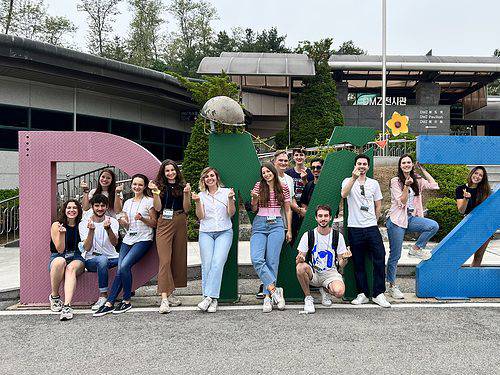
Best DMZ Tour From Seoul (No Forced Shopping)

Welcome Guest
Full day korea dmz and jsa (joint security area) tour from seoul.

Great tour!
Angelmylife, it was a nice look around., available tue, wed, thu, fri, sat, pick-up not available, what to expect, travelers interested in this activity also viewed, traveler's photos.
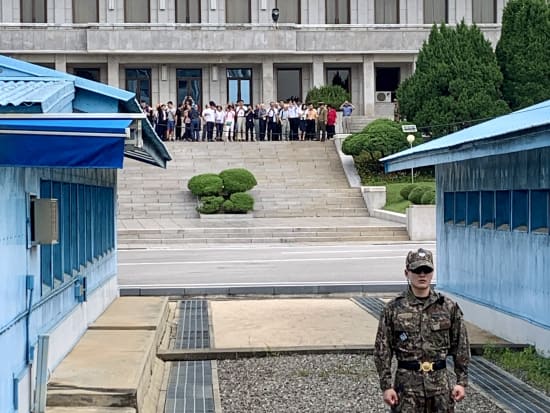
Overall rating
The tour guide was awesome, very knowledgeable and interesting. He loves his job. I had a great time. Some rude people kept talking over him...RUDE. The only complaint I have is that there were not any North Korean sol ... diers in the blue house. I would have liked to have seen one. We got exactly what was promised out of this tour. The bimbimbap was delish. We were warned that we may not get to go to visit the JSA, but we did get to. thank goodness. Loved it. It was an ALL day tour. Left in the morning and arrived home in the evening. Long ride home. :)
I've booked a DMZ and JSA tour but half a day before the tour should start, they cancelled the JSA part. It was okay. We saw various things like the tunnel to the boarder to North Korea, an observation platform where w ... e could see North Korea... but also a manufacturer for jewellery. I don't know why this should be a part of a tour concerning North Korea.
JSA and DMZ Canceled
After preparing fr months, making two expensive hotel bookings and stopping in Korea just for the tour then being canceled due to the African Swine Flu so very expensive and disappointing but not Veltra's fault. They han ... dled alternative tour and refund difference perfectly and Han our guide was wonderful. But sad I did not see what I traveled 8 thousands of miles to see.
Activity Provider Cosmojin Travel Agency
Activity provider, payment / cancellation policy.
- Credit card payment

- Any cancellations made after the booking confirmation date will be subject to a charge of 100% of the total amount.
Payment Methods

Cancellation Policy
Please visit VELTRA Support page to send an inquiry about this activity.
Editor's Picks for Seoul

Korea DMZ and JSA Tours: From Division to Peace
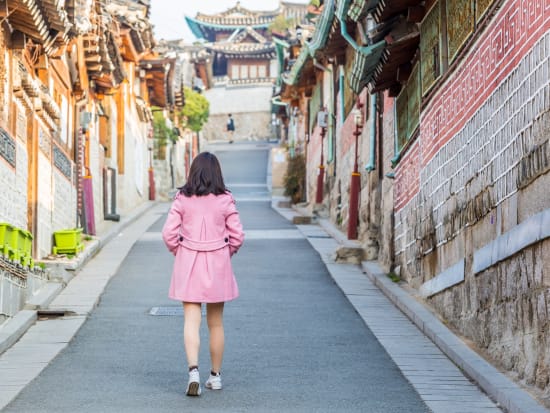
Last-Minute Activities and Essentials in Seoul

New on VELTRA! Seoul Tours and Things to Do
The Grandeur of Seoul's Royal Palaces

Best Tours of Nami Island from Seoul

Ride the Korean Wave

Top Shows You Should See in Seoul

Enthralling Amusement and Theme Parks near Seoul

Traditional Cultural Experiences in Seoul
日本語ガイド&オムレツ昼食付き, eur 152.00~.
You can only add up to 10 items in the list.
Please reduce items in the list.
- Children 11 years old and above can participate in this activity.
- The JSA area is under strict military jurisdiction and is subject to sudden closures. Scheduled tours may be changed or cancelled without prior notice at any moment. Guests will be offered alternatives or refund for affected tours.
- Guests with serious fear of enclosed spaces (claustrophobia), heart and cardiovascular issues, asthma or other respiratory problems are not permitted to enter the Third Tunnel. Walking through the Third Tunnel is not required. Guests may opt out and choose to stay in the bus, exhibition room or souvenir store.
- Korean passport holders or citizens residing in Korea will not be able to join this tour due to local laws. Citizens who live outside Korea will need to send a "Certification of Residence Overseas" to participate in this tour.
- Walking shoes
- The JSA has a strict dress code. Please dress appropriately in smart casual attire. Avoid revealing clothes such as sleeveless tops, short pants and skirts, ripped jeans, tight garments like leggings and open-toed shoes. Please refrain from wearing military-style outfits, biker gear, sports wear with logos and over-sized clothes.
- Following UNC rules, citizens of the following countries will be requested to submit a scanned copy of their passport (first page with photo) after booking to [email protected]:
- Afghanistan, Algeria, Azerbaijan, Bahrain, Bangladesh, Belarus, Bolivia, Bosnia, Burma, China, Cuba, Egypt, Estonia, Georgia, Hong Kong, India, Indonesia, Iran, Iraq, Jordan, Kazakhstan, Kuwait, Kyrgyzstan, Latvia, Lebanon, Libya, Lithuania, Macau, Malaysia, Moldova, Morocco, Nigeria, North Korea, Oman, Pakistan, Palestinian Authority, Qatar, Russia,Saudi Arabia, Singapore, Somalia, Sudan, Syria, Taiwan, Tajikistan, Tunisia, Turkmenistan, Ukraine, UAE, Uzbekistan, Venezuela, Vietnam, Yemen
- Names, nationalities and passport numbers (and copies of passport if needed) must be sent at least 72 hours before the tour. Without this information, the activity provider cannot confirm your seat.
- Every visitor has to use the authorized bus and follow time and photo regulations. The operator cannot be held responsible for any personal incidents or losses during the tour.
- The activity schedule is subject to change or cancellation due to weather or traffic conditions.
- When in the MAC conference rooms, please refrain from touching any equipment, microphone and flags that belong to the North Korean side.
- Please do not approach or engage with any personnel of North Korea. Do not speak to them or make any gestures.
- The following items are prohibited within the JSA premises: cameras with lens larger than 90mm, wheelchairs, walking sticks, umbrellas, luggage and big bags.
- STEP 3 Book another activity, and use the coupon for a discount!
- Valid for one (1) booking per account during the designated promotional period.
- Cannot be used on the same activity on the same date and time as the first activity, or applied to activities that have already been booked.

- Company Information
- Investor Relations
- News Release
- Supplier Sign-in
- Add Your Activity
- Privacy Policy
- Basic Policy on Information Security
- Terms & Conditions

Winter is here! Check out the winter wonderlands at these 5 amazing winter destinations in Montana
- Travel Destinations
How To Visit Korea’s JSA & The DMZ Tour (Guide & Tips)
Published: September 10, 2023
Modified: December 27, 2023
by Gilberta Hewitt
- Plan Your Trip
- Travel Guide
- Travel Tips
- South Korea
Introduction
Welcome to the enchanting and historically significant world of Korea’s Joint Security Area (JSA) and Demilitarized Zone (DMZ) tour. This unique journey offers visitors a rare glimpse into the political and military complexities of the Korean Peninsula.
Situated just 35 miles north of Seoul, the JSA & DMZ serve as a powerful reminder of the division between North and South Korea. It is a place where past and present intersect, where tension and curiosity coexist, making it a must-visit destination for history buffs, adventure seekers, and those interested in geopolitics.
The JSA, also known as Panmunjom, is the only point where North and South Korean soldiers stand face-to-face. It is a symbol of the ongoing ceasefire agreement and the fortified border that separates the two nations. On the other hand, the DMZ spans 2.5 miles on either side of the border, creating a buffer zone that preserves a fragile peace.
In this comprehensive guide, we will provide you with all the necessary information to ensure a memorable and smooth JSA & DMZ tour experience. We will cover everything from understanding the significance of these areas to preparing for the journey, booking a tour, navigating security regulations, and exploring the key highlights of the JSA and DMZ.
Whether you are a history enthusiast wanting to witness the vestiges of the Korean War, a curious traveler intrigued by geopolitics, or simply someone seeking a unique and offbeat adventure, the JSA & DMZ tour offers something for everyone.
So, buckle up as we unravel the wonders of the JSA & DMZ and guide you through this fascinating journey into one of the most politically charged regions in the world.
Understanding the JSA & DMZ
Before embarking on your JSA & DMZ tour, it’s essential to grasp the historical and political significance of these areas. The Joint Security Area (JSA) and the Demilitarized Zone (DMZ) play a crucial role in the ongoing conflict between North and South Korea.
The JSA, also known as Panmunjom, is a small area within the DMZ where meetings between the two Koreas take place. It is the only spot where North Korean and South Korean soldiers stand face-to-face, creating a visually captivating and tense atmosphere. This is highly symbolic of the division and ongoing ceasefire agreement between the two nations.
The DMZ, on the other hand, is a 2.5-mile-wide de facto border that stretches across the Korean Peninsula. This buffer zone was established at the end of the Korean War in 1953 to maintain a fragile peace between the two countries. It acts as a demilitarized zone, limiting military presence and activities, while also preserving a unique ecosystem that has flourished in the absence of human interference.
The DMZ has become a significant tourist attraction, offering a glimpse into the history and current state of affairs between North and South Korea. It houses various landmarks, such as the Third Tunnel of Aggression, the Dora Observatory, and the Imjingak Park, each carrying its own story and historical context.
One of the most remarkable features of the JSA is the famous blue conference buildings, where inter-Korean meetings take place. The building itself straddles the military demarcation line, with one half technically belonging to North Korea and the other half to South Korea. Visitors to the JSA can step inside these buildings and stand in both countries simultaneously, experiencing a truly unique and surreal moment.
Understanding the historical context and geopolitical dynamics of the JSA & DMZ will enrich your tour experience, allowing you to appreciate the significance of the sites you will visit. It’s essential to approach the tour with an open mind and a willingness to learn about the complexities and challenges faced by the two Koreas.
Now that you have a better understanding of the JSA & DMZ, it’s time to prepare for your journey. In the next section, we will provide you with essential tips on how to plan and book your tour.
Preparing for the Tour
Embarking on a tour to the JSA & DMZ requires careful preparation to ensure a smooth and fulfilling experience. Here are some essential tips to help you get ready for your journey:
- Check travel advisories: Before planning your tour, it’s crucial to check the latest travel advisories and warnings issued by your government. Ensure that it is safe to visit the area and that there are no restrictions or security concerns.
- Reserve in advance: Due to high demand and limited daily visitor quotas, it’s advisable to book your JSA & DMZ tour well in advance. This will secure your spot and allow you to choose from various tour options.
- Choose a reputable tour operator: Selecting a reliable and experienced tour operator is vital for a successful JSA & DMZ tour. Look for operators with positive reviews, knowledgeable guides, and adherence to safety protocols.
- Prepare necessary documents: Carry your passport or identification document with you as it will be required for verification purposes at the security checkpoints. Additionally, ensure to have a printed copy of your tour confirmation or e-ticket.
- Dress appropriately: As the JSA & DMZ are active military areas, wearing casual, comfortable clothing is recommended. Avoid clothing with provocative slogans or symbols, and do not wear clothing resembling military uniforms.
- Observe photography restrictions: There are certain areas within the JSA & DMZ where photography is strictly prohibited. Follow the instructions of your tour guide and respect these limitations to avoid any unwanted complications.
- Pack essentials: Carry essential items such as sunscreen, a hat, sunglasses, a reusable water bottle, and a raincoat or umbrella, as the weather can change unexpectedly. It’s also advisable to pack some snacks for the tour as food options may be limited.
- Follow security guidelines: A visit to the JSA & DMZ involves passing through multiple security checkpoints. Be prepared to undergo security screenings, including bag checks and metal detector scans. Follow the instructions of the tour guide and security personnel at all times.
- Be respectful and mindful: The JSA & DMZ hold significant historical and political importance. Show respect for the solemnity of the sites and the military personnel present. Refrain from making inappropriate jokes or engaging in disruptive behavior.
By following these preparatory steps, you will be well-equipped to embark on a fulfilling and memorable tour to the JSA & DMZ. The next section will guide you through the process of booking a tour to ensure you secure your spot and make the most of your visit.
Booking a Tour
Booking a tour to the JSA & DMZ is the most convenient and recommended way to visit these historically significant areas. Here are some key considerations when booking your tour:
- Research different tour options: Start by conducting thorough research on various tour operators that offer JSA & DMZ tours. Look for reputable companies that have positive reviews, experienced guides, and comprehensive itineraries.
- Compare tour packages: Take the time to compare different tour packages and their inclusions. Some tours may prioritize specific sites within the JSA & DMZ, so choose a tour that aligns with your interests and preferences.
- Check availability: Due to limited daily visitor quotas, it’s crucial to check the availability of tours on your chosen date. Popular months and weekends tend to get booked quickly, so plan ahead and secure your spot early.
- Consider additional attractions: Some tour packages may include visits to additional attractions near the JSA & DMZ, such as the Third Tunnel of Aggression or the Dora Observatory. If you’re interested in exploring these sites, look for tours that offer these options.
- Read reviews and testimonials: Before finalizing your booking, read reviews and testimonials from previous tour participants. This will give you insights into the experiences of others and help you make an informed decision.
- Check cancellation policy: Ensure you are familiar with the tour operator’s cancellation policy. Circumstances may change, and having a clear understanding of the cancellation terms will provide you with peace of mind.
- Book through a reputable platform: Use trusted booking platforms or directly book through the tour operator’s official website. This will help ensure the legitimacy of your reservation and minimize the risk of fraudulent activities.
- Provide accurate information: When booking your tour, make sure to provide accurate personal details, including your full name, passport or ID number, and contact information. Double-check the information for any errors before submitting your reservation.
- Confirm the meeting point: Pay attention to the meeting point provided by the tour operator. Familiarize yourself with the location and plan your transportation accordingly to arrive on time.
- Keep a copy of your reservation: Once your tour is booked, keep a digital or printed copy of your reservation confirmation. This will serve as proof of your booking and make the check-in process smoother on the day of the tour.
By following these guidelines, you can easily navigate the process of booking a tour to the JSA & DMZ. Booking in advance ensures that you secure your spot and grants you peace of mind, knowing that your visit to these historically significant areas is well organized.
Next, we will discuss the various transportation options available to reach the JSA & DMZ for your tour.
Getting to the JSA & DMZ
Reaching the Joint Security Area (JSA) and the Demilitarized Zone (DMZ) for your tour requires careful consideration of transportation options. Here are the main ways to get to the JSA & DMZ:
- Join a guided tour: The most popular and convenient way to reach the JSA & DMZ is by joining a guided tour. Tour operators provide organized transportation with pick-up and drop-off points in major cities, such as Seoul. This eliminates the hassle of navigating public transportation and ensures you have a knowledgeable guide throughout the journey.
- Public transportation: If you prefer to explore on your own, you can use public transportation to reach the JSA & DMZ. From Seoul, take the subway or a local bus to Imjingak Park, a central area near the DMZ. From there, you can transfer to a designated shuttle bus that takes visitors to the JSA and other key sites within the DMZ.
- Hire a private driver: For a more personalized experience, you can hire a private driver to take you to the JSA & DMZ. This option offers flexibility in terms of itinerary and allows for customization based on your interests and schedule.
- Group tours: Some organizations and universities also organize group tours to the JSA & DMZ. These tours often include transportation and provide a unique opportunity to explore the area with like-minded individuals.
- DMZ Train: The DMZ Train is a popular option for visitors who want a scenic journey to the DMZ. This train departs from Seoul and takes you through the beautiful countryside before arriving at the DMZ. From there, shuttle buses are available to transfer you to the JSA and other attractions.
It’s important to note that regardless of the transportation option you choose, access to the JSA is only possible through guided tours, as it is a highly secure military area.
When planning your journey to the JSA & DMZ, consider factors such as convenience, time constraints, and personal preferences. Guided tours provide a hassle-free experience, while public transportation and private drivers offer more flexibility and customization.
Next, let’s delve into the security regulations and guidelines you need to be aware of before visiting the JSA & DMZ.
Security and Regulations
Visiting the Joint Security Area (JSA) and the Demilitarized Zone (DMZ) requires strict adherence to security regulations. As these areas are still active military zones, it’s essential to be aware of the following guidelines:
- Identification and registration: When entering the JSA & DMZ, all visitors must present a valid identification document, such as a passport. This is necessary for security purposes and to ensure that only authorized individuals enter the area. Along with ID verification, visitors are also required to register their personal information before entering the JSA.
- No inappropriate behavior: Respect the solemnity and sensitivity of the JSA & DMZ by refraining from inappropriate behavior, such as making jokes, taking selfies in inappropriate locations, or engaging in disruptive behavior. Follow the instructions provided by the tour guide and security personnel at all times.
- No pointing or gesturing: It is strictly prohibited to point, gesture, or make any provocative actions towards North Korean soldiers or personnel. While it may seem harmless, such actions can escalate tensions and compromise the security and integrity of the area.
- Stay within designated areas: During the tour, it’s important to stay within the designated areas and follow the instructions of your tour guide. Straying from the identified paths or crossing into unauthorized areas is not allowed, as it can jeopardize personal safety and violate security regulations.
- Be mindful of photography restrictions: Certain areas within the JSA & DMZ have strict photography restrictions. Listen to your tour guide and follow their instructions regarding where photography is allowed and where it is prohibited. Ignoring these guidelines can lead to confiscation of equipment or other consequences.
- Respect dress code: As the JSA & DMZ are military areas, it’s important to dress appropriately. Avoid wearing clothing with provocative slogans or symbols, and do not wear attire resembling military uniforms. Dress comfortably, and consider the weather conditions when choosing your outfit.
- Do not bring restricted items: Leave behind any items that are considered restricted within the JSA & DMZ, such as weapons, drones, large backpacks, or flammable substances. Security checks are conducted, and bringing restricted items can result in delays or denial of entry.
- Follow emergency procedures: In the event of an emergency or unforeseen situation, listen to the instructions provided by your tour guide and follow their lead. They are trained to handle any unexpected incidents and will prioritize your safety and well-being.
- Stay informed: Stay updated on any changes in security regulations or guidelines prior to your visit. Check the official websites or contact your tour operator for the most up-to-date information. It is your responsibility to stay informed and comply with the regulations in place.
By adhering to these security regulations and guidelines, you can ensure a safe and respectful visit to the JSA & DMZ. Remember, these areas are sensitive and hold deep historical and political significance, so it is essential to approach the tour with a responsible and mindful attitude.
Now that you are familiar with the security regulations, it’s time to delve into the highlights and key attractions of the Joint Security Area (JSA) and the Demilitarized Zone (DMZ) in the next section.
Exploring the Joint Security Area (JSA)
The Joint Security Area (JSA), also known as Panmunjom, is the heart of the Korean Demilitarized Zone (DMZ) and a highlight of any visit to this region. Here, visitors have the unique opportunity to witness the standoff between North and South Korea and experience the tension and history firsthand.
Upon arrival at the JSA, you will be guided through various significant sites by a knowledgeable tour guide. Here are some key highlights you can expect to explore:
- Panmunjom: Panmunjom is the main area within the JSA where negotiations between North and South Korea take place. It’s an iconic symbol of the division between the two nations. Visitors can step into the blue conference buildings, where inter-Korean meetings occur. Standing precisely on the military demarcation line, you can find yourself in both North and South Korea simultaneously, creating a truly surreal experience.
- Freedom House and Conference Row: Freedom House is a building located within the JSA that was built for inter-Korean reunions. It serves as a venue for various diplomatic engagements and discussions. Nearby, you can also witness the Conference Row, a series of buildings where military officials from both sides of the border convene for meetings.
- Bridge of No Return: The Bridge of No Return holds historical significance as the site where prisoner exchanges took place during the Korean War. It got its name after the war when prisoners were given the choice to stay in their captor’s country or return to their home country. Once they crossed this bridge, there was no turning back.
- Peace Bell: The Peace Bell is a striking monument located within the JSA. It serves as a symbol of hope and unity for the Korean people, reminding visitors of the importance of peace and reconciliation on the Korean Peninsula.
- Observation Points: As part of the JSA tour, you will have the opportunity to visit observation points that overlook North Korea. These points allow you to glimpse into the neighboring country and witness the stark contrast between the two sides of the border.
Exploring the Joint Security Area provides a profound insight into the ongoing tensions and political complexities of the Korean Peninsula. It’s a chance to witness history in action and gain a deeper understanding of the challenges faced by both North and South Korea.
Now, let’s move on to the next section, where we will unveil the captivating sites and experiences offered by the Demilitarized Zone (DMZ).
Visiting the Demilitarized Zone (DMZ)
The Demilitarized Zone (DMZ) is a captivating and historically significant area that stretches across the Korean Peninsula, separating North and South Korea. A visit to the DMZ offers a unique opportunity to understand the geopolitical dynamics and experience the remnants of the Korean War. Here are some key highlights and experiences you can expect when visiting the DMZ:
- The Third Tunnel of Aggression: One of the most intriguing sites within the DMZ is the Third Tunnel of Aggression. This tunnel was discovered in 1978 and is believed to have been crafted by North Korea as a potential invasion route into South Korea. Visitors can explore a section of the tunnel and learn about its historical significance.
- Dora Observatory: The Dora Observatory provides a panoramic view of the DMZ and the surrounding area. On a clear day, you can even catch a glimpse of the North Korean city of Kaesong. This observatory not only offers stunning views but also serves as a reminder of the division and the desire for reunification.
- Imjingak Park: Imjingak Park is a symbolic area located near the DMZ, offering a peaceful and reflective atmosphere. It features landmarks like the Bridge of Freedom, which was used by prisoners of war returning to South Korea, and the Freedom Bell, which represents the hope for reunification. Imjingak Park is a poignant reminder of the shared history and aspirations of the Korean people.
- Panoramic view from Dora Sanzan: For an even more striking view of the DMZ, you can visit Dora Sanzan, a trio of hills located near the border. From here, you can witness the vast expanse of the DMZ and appreciate the stark contrast between the heavily guarded border and the peaceful landscape beyond.
- Unification Bridge: The Unification Bridge is a symbolic suspension bridge that spans the Imjin River, connecting North and South Korea. While visitors cannot cross the bridge, it serves as a reminder of the hope for reunification and the desire to bridge the gap between the two nations.
A visit to the DMZ offers not only a chance to witness the physical division but also an opportunity to reflect on the shared history and aspirations of the Korean people. It serves as a powerful reminder of the ongoing strive for peace and reunification.
Now that you are familiar with the highlights of the DMZ, it’s time to delve into some essential tips and advice to make the most of your JSA & DMZ tour. Continue reading to ensure a memorable and enriching experience!
Important Tips and Advice
To ensure a smooth and enjoyable JSA & DMZ tour experience, here are some essential tips and advice to consider:
- Follow instructions and guidelines: Always listen to the instructions provided by your tour guide and follow any guidelines given. They are there to ensure your safety and the integrity of the areas you will visit.
- Arrive early: Plan to arrive early at the meeting point to avoid any delays or rushing. This will give you time to check-in, go through security checks, and familiarize yourself with the tour itinerary.
- Respect the solemnity of the sites: Both the JSA and the DMZ are areas of deep historical and political significance. Show respect and refrain from making jokes or engaging in inappropriate behavior that may diminish the seriousness of the locations.
- Stay with the group: Throughout the tour, it’s essential to stay with your tour group and follow the designated paths. Straying from the group or crossing into unauthorized areas is strictly prohibited for security reasons.
- Keep your personal belongings secure: As you will be passing through various security checkpoints, keep your personal belongings secure and watchful. Avoid bringing unnecessary valuables and always keep an eye on your belongings to prevent any loss or confusion.
- Stay informed about the latest news: Keep yourself updated on any changes or developments related to the JSA & DMZ. This includes checking official websites and monitoring news updates to ensure you have the most accurate information before your tour.
- Be mindful of the sensitivities: Remember that visiting the JSA & DMZ is a unique experience that involves the ongoing political and military tensions between North and South Korea. Be mindful of the sensitivities and avoid engaging in discussions or actions that may cause unnecessary tension.
- Engage with your tour guide: Make the most of your tour by engaging with your knowledgeable tour guide. They can provide valuable insights, answer your questions, and enhance your understanding of the sites you visit.
- Capture memories respectfully: Photography is allowed in certain areas, but be mindful of the restrictions and guidelines. Respect the privacy of others and the solemn nature of the sites when capturing your memories. Avoid taking selfies in inappropriate locations and always ask permission before taking photos of other visitors or military personnel.
- Reflect on the experience: After the tour, take a moment to reflect on the experience and the knowledge you have gained. The JSA & DMZ tour offers a unique perspective on the complex history and political situation of the Korean Peninsula, and embracing this opportunity for reflection can enhance your overall understanding and appreciation.
By keeping these tips and advice in mind, you can ensure a respectful, safe, and enlightening JSA & DMZ tour. Now, armed with essential knowledge, prepare for an unforgettable journey through the fascinating world of the Joint Security Area and the Demilitarized Zone.
To conclude, the JSA & DMZ tour is a profound adventure that offers a rare opportunity to witness the ongoing division and historical significance of the Korean Peninsula. It’s a journey that combines geopolitics, history, and cultural understanding, leaving visitors with a deeper appreciation for the complexities and struggles faced by the Korean people. So, get ready to embark on this extraordinary venture and immerse yourself in the mesmerizing world of the JSA & DMZ!
The Joint Security Area (JSA) and the Demilitarized Zone (DMZ) tour offers a remarkable opportunity to explore the historical, political, and cultural complexities of the Korean Peninsula. This journey provides a deeper understanding of the ongoing division between North and South Korea while allowing visitors to witness firsthand the tension and symbolism of these areas.
From standing in both North and South Korea simultaneously at the JSA to exploring the historical sites within the DMZ, such as the Third Tunnel of Aggression and the Dora Observatory, every step of the tour is filled with profound insights and thought-provoking experiences.
To make the most of your JSA & DMZ tour, it’s essential to prepare in advance, book your tour with reputable operators, and adhere to the security regulations. By following these guidelines, you ensure a smooth and safe experience as you delve into the fascinating world of the Korean Demilitarized Zone.
As you journey through the JSA and the DMZ, remember to approach each site with respect, mindfulness, and a desire to learn. Engage with your knowledgeable tour guide, capture memories respectfully, and be cognizant of the sensitivities surrounding the ongoing conflict.
By the end of your tour, you will leave with a profound understanding of the historical significance, political challenges, and aspirations for peace and reunification that define the Korean Peninsula. The JSA & DMZ tour offers an incredible journey that will leave an indelible mark on your understanding of this region.
So, prepare for a captivating adventure as you unravel the wonders of the Joint Security Area and the Demilitarized Zone. Embrace the unique experiences, reflect on the complexities of the Korean Peninsula, and return home with a deeper appreciation for the historical and geopolitical intricacies that shape this captivating part of the world.

- Privacy Overview
- Strictly Necessary Cookies
This website uses cookies so that we can provide you with the best user experience possible. Cookie information is stored in your browser and performs functions such as recognising you when you return to our website and helping our team to understand which sections of the website you find most interesting and useful.
Strictly Necessary Cookie should be enabled at all times so that we can save your preferences for cookie settings.
If you disable this cookie, we will not be able to save your preferences. This means that every time you visit this website you will need to enable or disable cookies again.
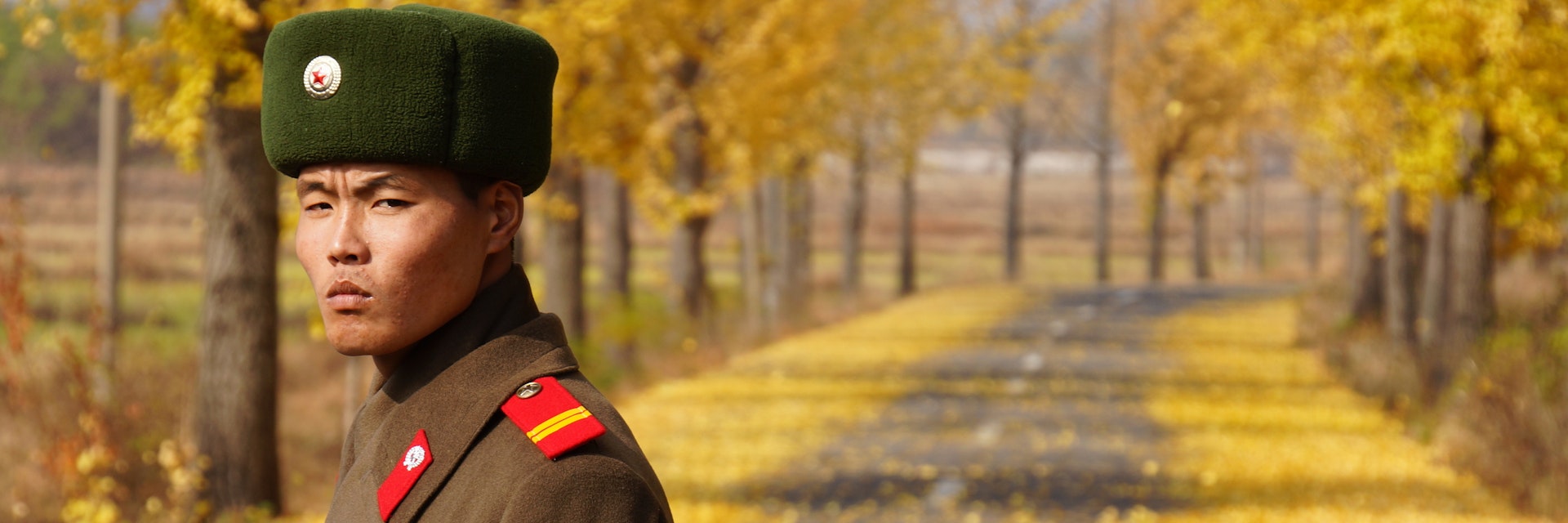
Joint Security Area
Unquestionably the highlight of any trip to the DMZ is the Joint Security Area (JSA) at Panmunjeom. An improbable tourist destination, it's here where the infamous Military Demarcation Line separates South and North Korea. Soldiers from both sides often stand metres apart eyeballing one another from their respective sides of the blue-painted UN buildings. You'll be taken inside the meeting room – where the 1953 truce was signed – the only place where you can safely walk into North Korea.
Tours kick off with a briefing by US or Republic of Korea (ROK, South Korea) soldier guides at Camp Bonifas, the joint US–ROK army camp just outside the DMZ, before being transferred to another bus to the JSA.
Within the blue conference room at the JSA, where official meetings are still sometimes held, microphones on the tables constantly record everything said, while ROK soldiers stand guard inside and out in a modified taekwondo stance – an essential photo op. Their North Korean counterparts keep a steady watch, usually, but not always, from a distance.
Though your tour will be a quiet one, the soldier guide will remind you that this frontier is no stranger to violent incidents. One of the most notorious was in 1976 when two US soldiers were hacked to death with axes by North Korean soldiers after the former tried to chop down a tree obstructing the view from a watchtower. Camp Bonifas, the joint US–ROK army camp just outside the DMZ, is named after one of the slain soldiers.
Back on the bus you’ll be taken to one of Panmunjeom’s lookout posts from where you can see the two villages within the DMZ: Daeseong-dong in the South and Gijeong-dong in the North. You'll also see the Bridge of No Return where POW exchange took place following the signing of Armistice Agreement in 1953.
Ironically, the forested surrounds here, long since abandoned, are some of the most ecologically pristine in Korea, even thought to be home to the Siberian tiger.
Suggest an edit to this attraction
Lonely Planet's must-see attractions
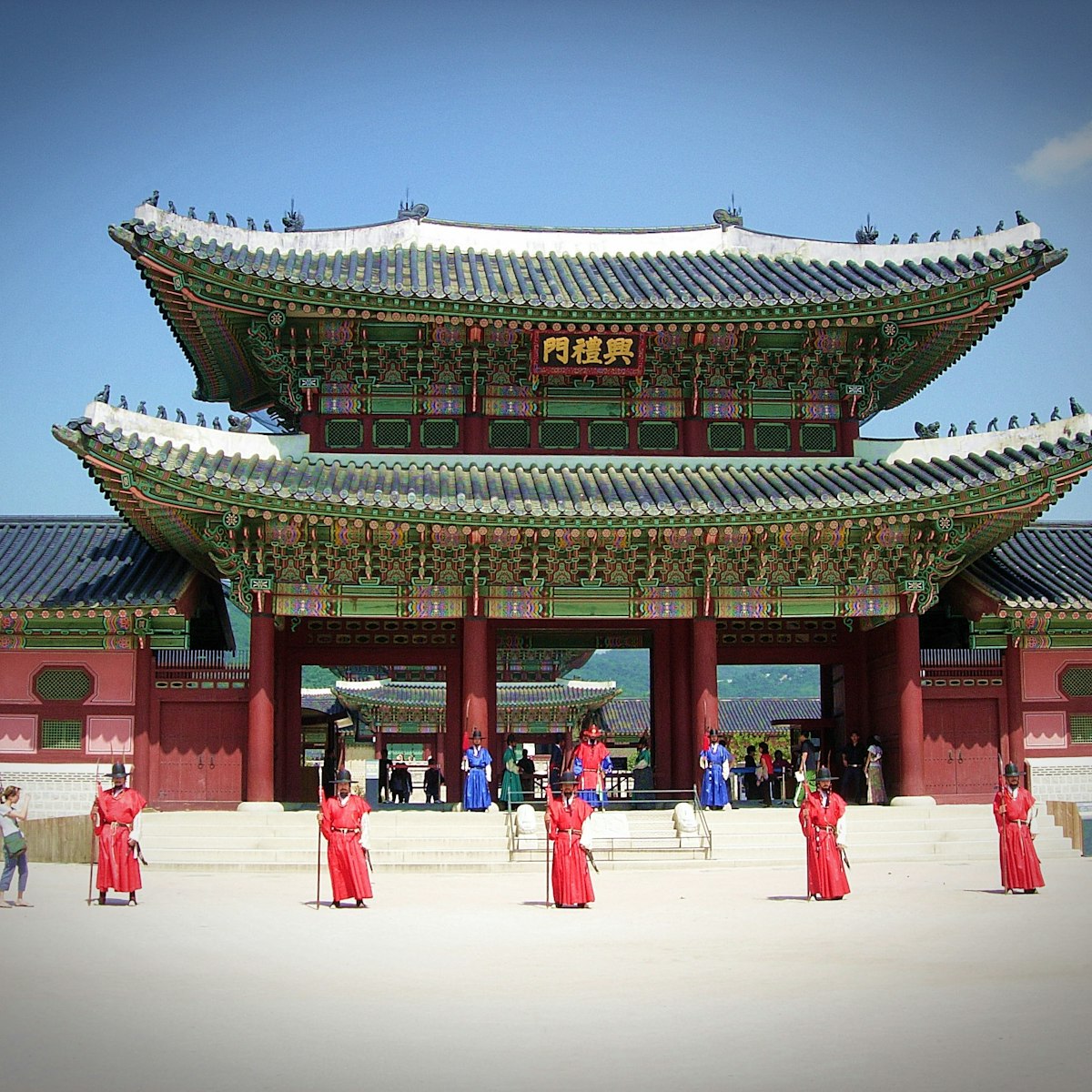
Gyeongbokgung
28.02 MILES
Like a phoenix, Seoul’s premier palace has risen several times from the ashes of destruction. Hordes of tourists have replaced the thousands of government…
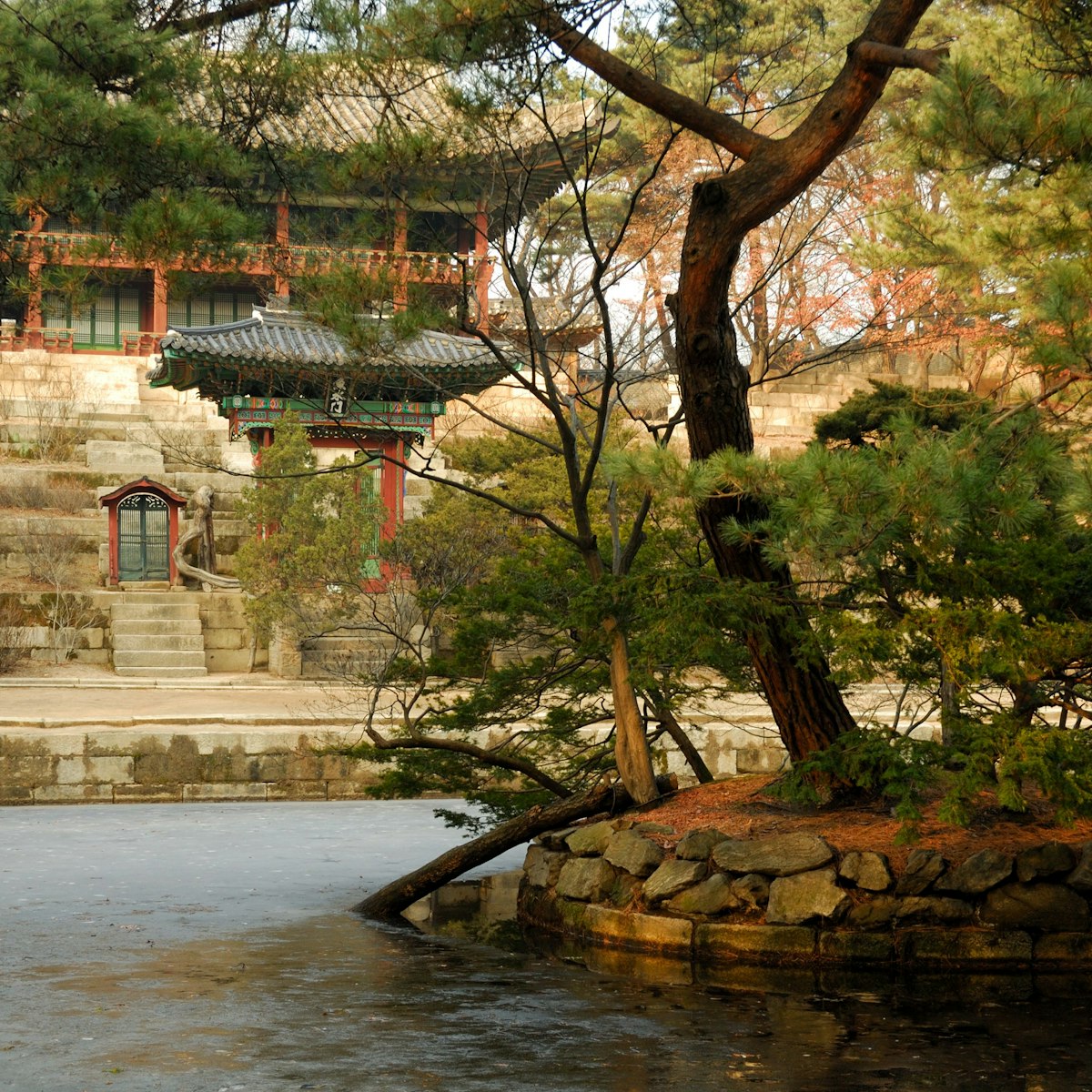
Changdeokgung
28.36 MILES
The World Heritage–listed Changdeokgung is the most beautiful of Seoul's five main palaces. You must join a one-hour guided tour to look around. English…
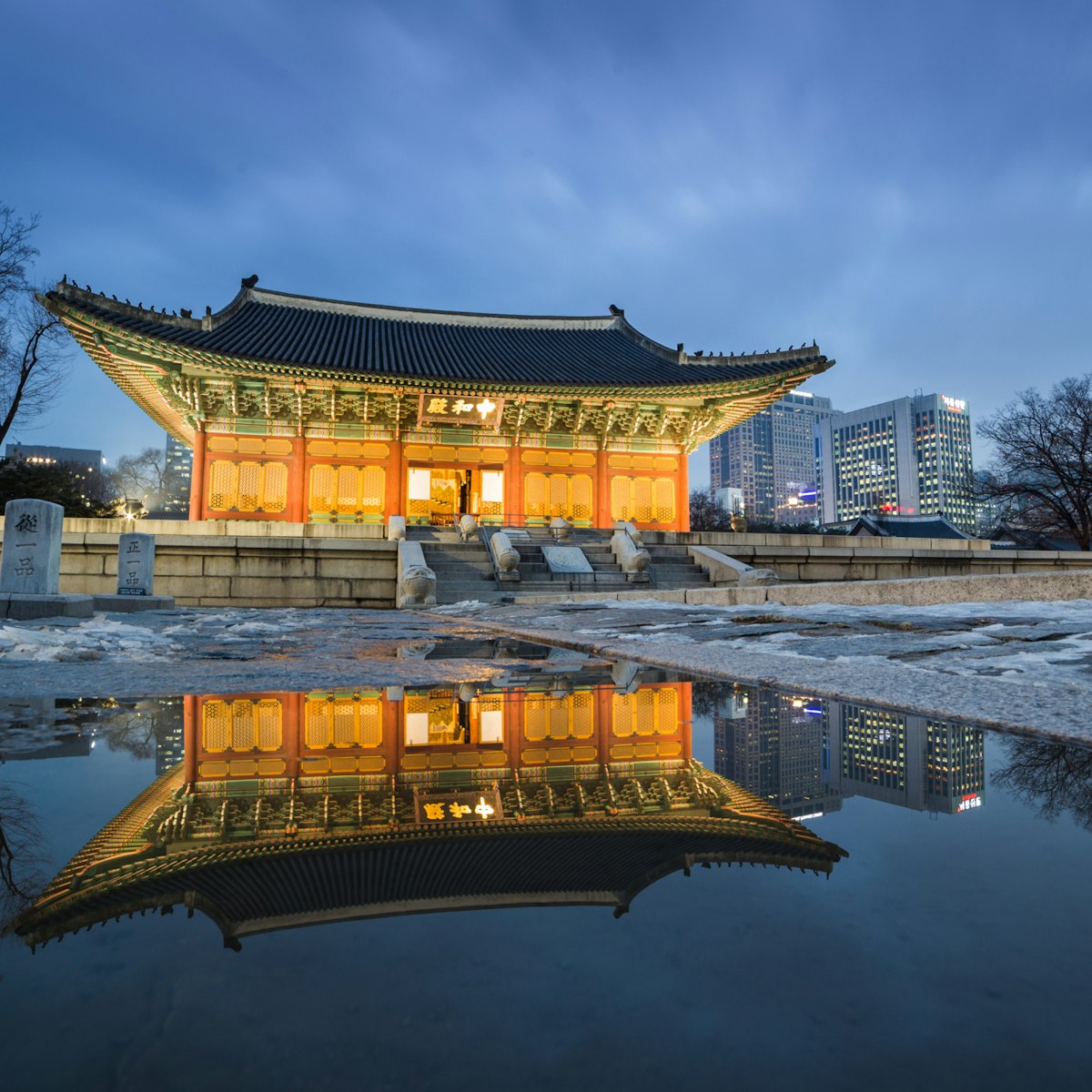
28.77 MILES
One of Seoul's five grand palaces built during the Joseon dynasty, Deoksugung (meaning Palace of Virtuous Longevity) is the only one you can visit in the…
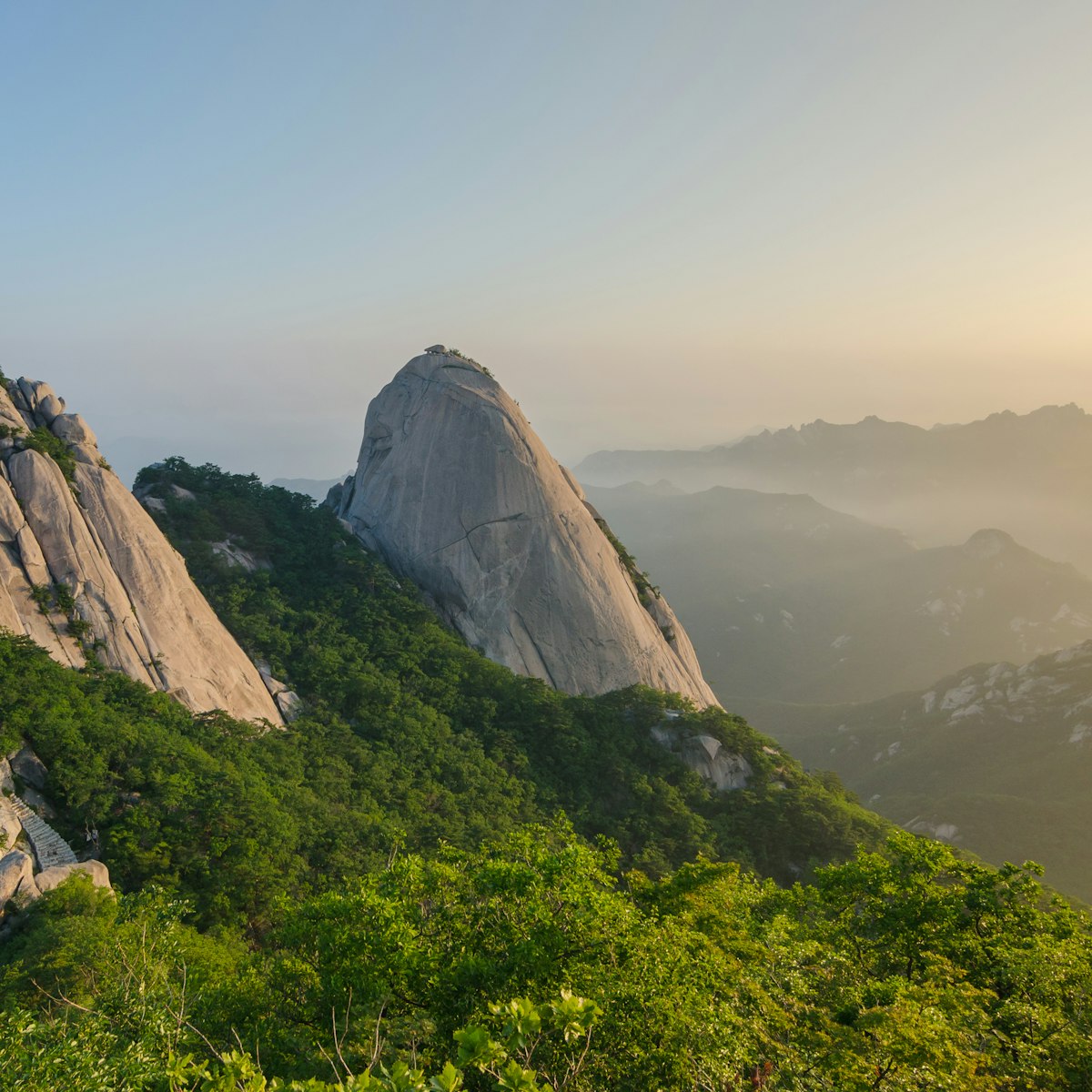
Bukhansan National Park
22.58 MILES
Granite-peak-studded Bukhansan National Park's sweeping mountaintop vistas, maple leaves, rushing streams and remote temples draw over 5 million hikers…
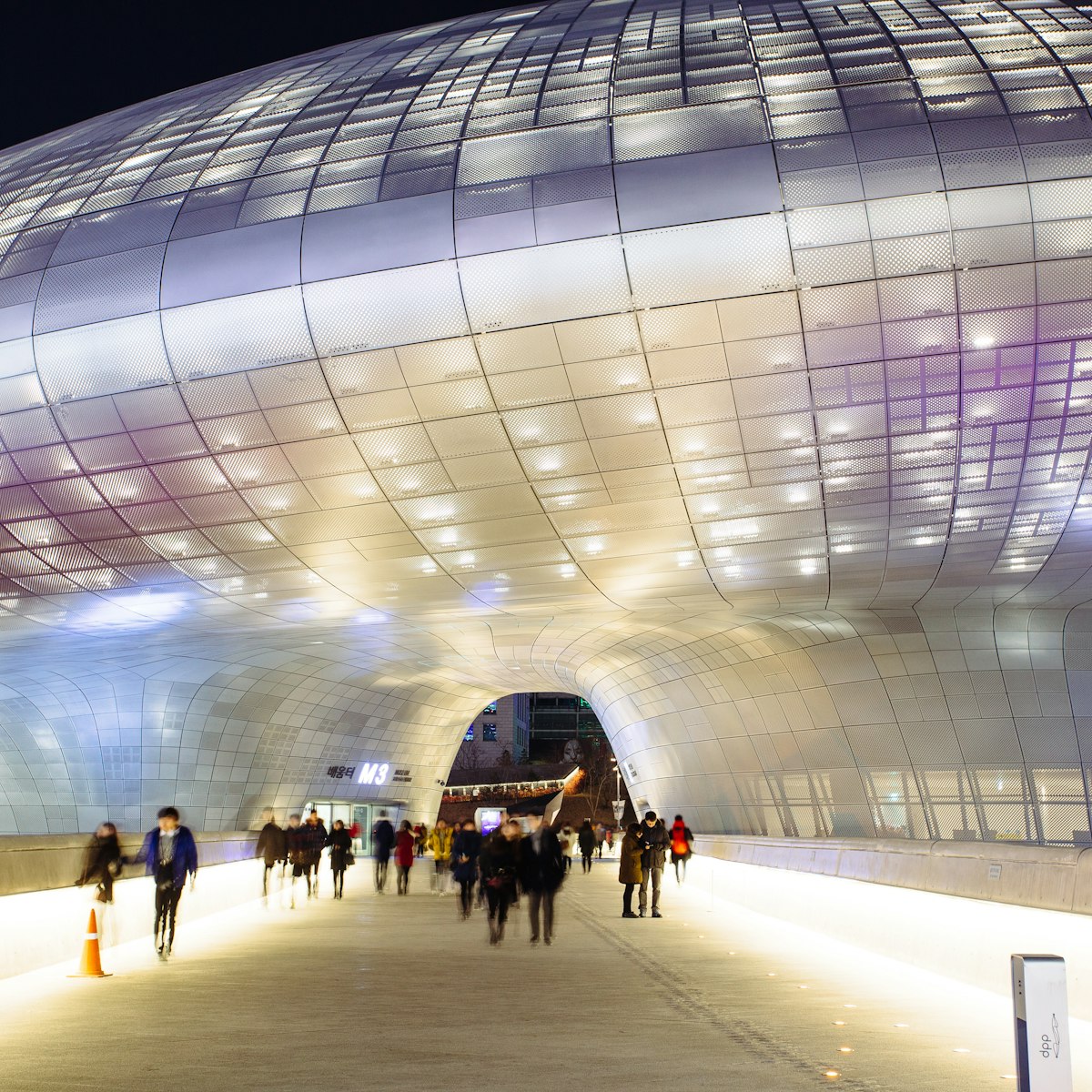
Dongdaemun Design Plaza & Park
29.67 MILES
Designed by the late Zaha Hadid, this neofuturistic cultural complex was commissioned to replace the Dongdaemun Stadium, built during Japanese rule in the…
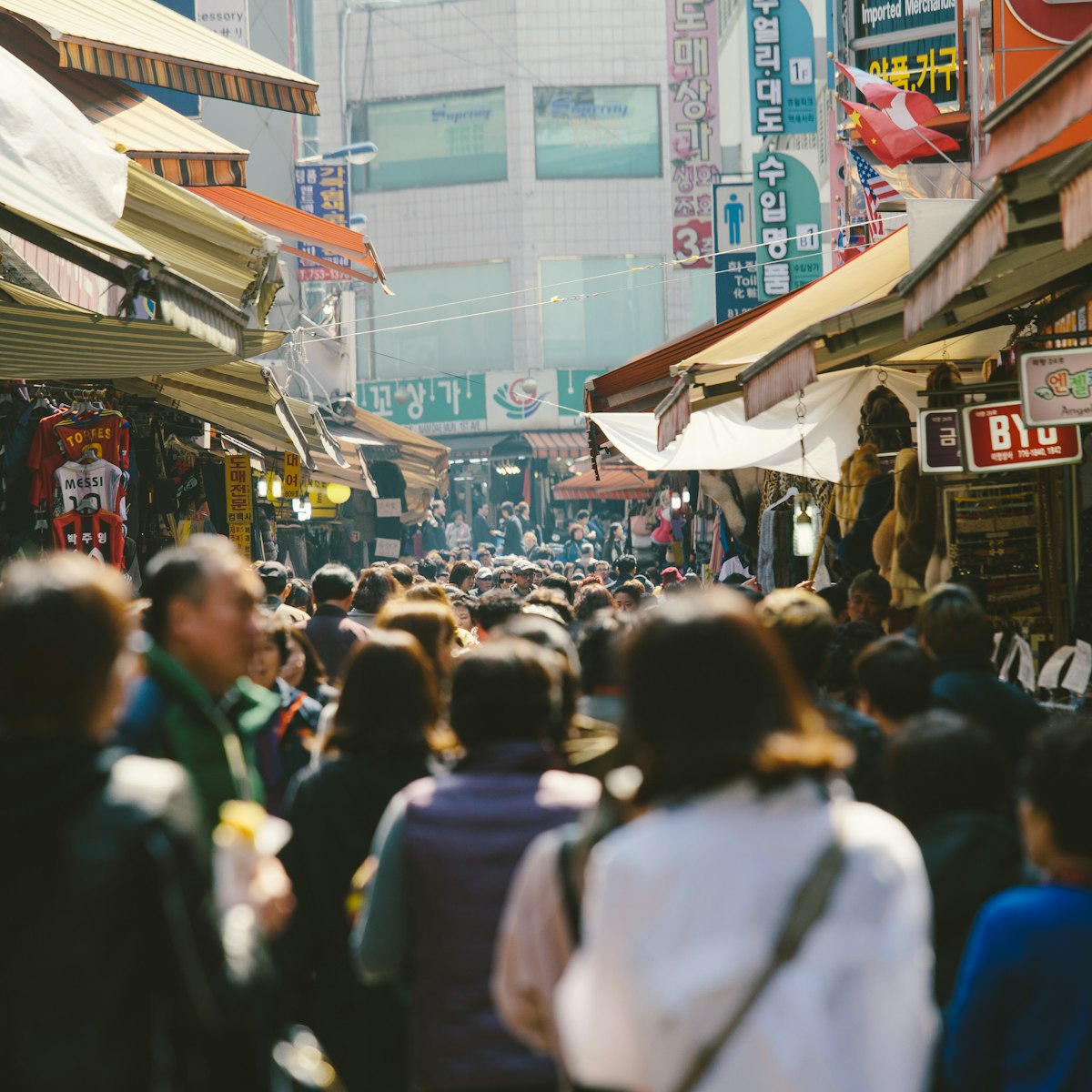
Namdaemun Market
You could spend all day in this swarming night-and-day market and not see it at all. The largest market in Korea, each section has hundreds of stalls,…
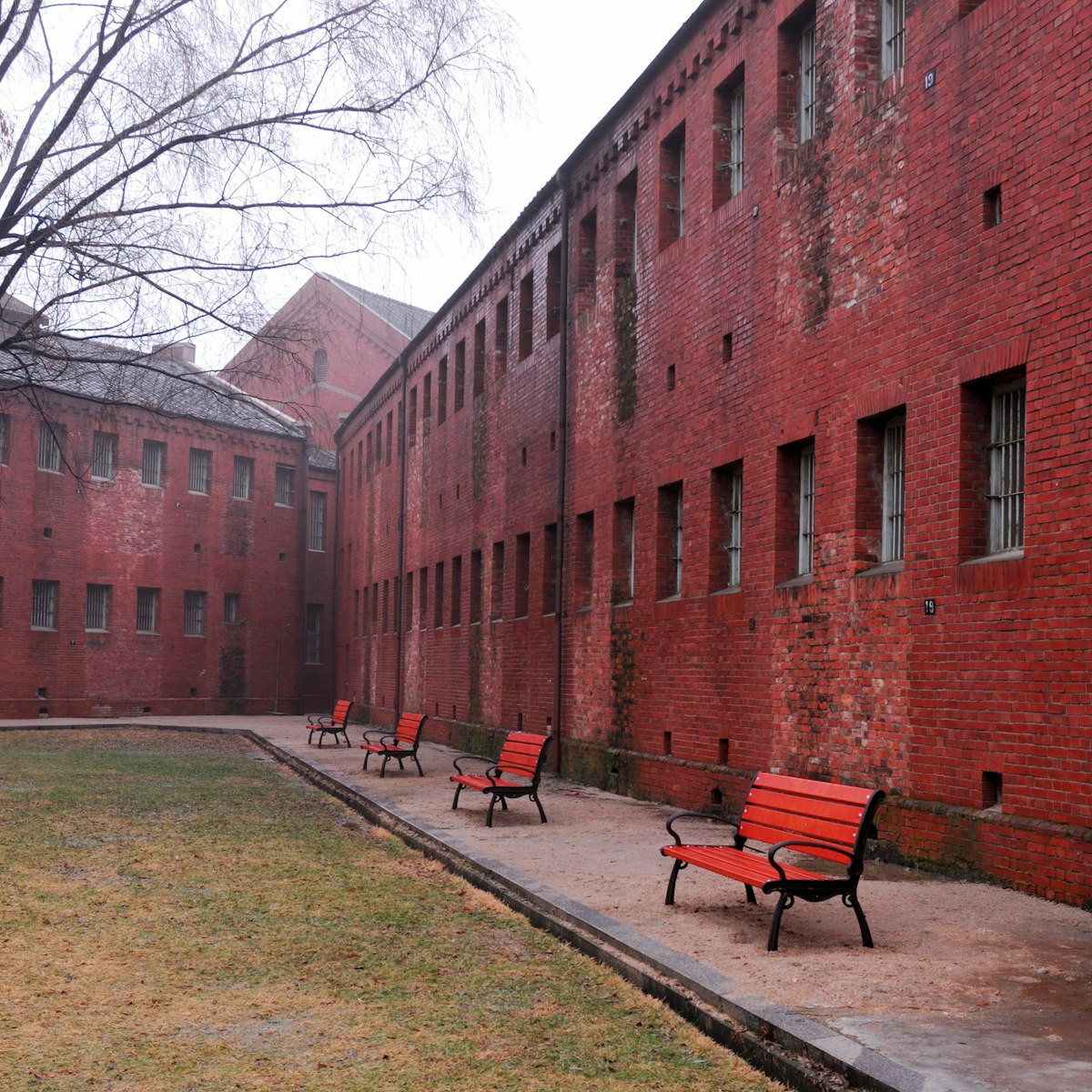
Seodaemun Prison History Hall
27.78 MILES
Built in 1908, this former prison is a potent symbol of Korean suffering at the hands of Japan during colonial occupation in the early 20th century…

Cheong-gye-cheon
28.66 MILES
With its landscaped walkways, footbridges, waterfalls and a variety of public artworks, such as the enormous pink-and-blue shell entitled Spring in Cheong…
Nearby The DMZ attractions
1 . Third Infiltration Tunnel
Since 1974, four tunnels have been found running under the DMZ, dug by the North Koreans so that their army could launch a surprise attack. Walking along…
2 . Dora Observatory
Peer through binoculars for a voyeuristic glimpse into the Democratic People's Republic of Korea (DPRK; North Korea). On a clear day you can make out…
3 . Dorasan Peace Park
This mildly diverting park has a couple of modern Korean tanks, some deer, an outdoor photo display and a few saplings called, groovily, the Paul…
4 . Dorasan Train Station
Awaiting the next departure to Pyongyang (and onward trans-Eurasian intercontinental travel), Dorasan train station stands as a symbol of hope for the…
5 . Imjingak
This park is dedicated to the 10 million South Koreans separated from their families when the peninsula was divided postwar. Also here is the Freedom…
6 . Gallery SoSo
There's nothing so-so about this modernist, wood-panelled gallery building backing on to the forested hillside. The engaging exhibitions mostly feature…
7 . White Block Art Centre
10.09 MILES
In the centre of the village, this is one of Heyri's larger-scale galleries with three floors showcasing contemporary art. Outside stands the blue…
8 . Blume Museum of Contemporary Art
This contemporary gallery exhibits a mix of emerging and established artists across all mediums. It's inside a postmodern building designed by Korean…

JSA Panmunjom Guided Tour
from ₩95,000/person
- Pickup & Dropoff At Hotel President (Nearest subway is at City Hall Station or Euljiro 1(il)-ga Station)
- Whole Day Tour (09:50am - 4:30pm)
- English Speaking Tour Guide
JSA Panmunjom Program
- Lunch (Beef Bulgogi)
JSA (Joint Security Area)
Visit the only place where North & South Korean forces stand face-to-face and experience the tensions faced everyday at JSA Panmunjom. For the lucky few, you might even get to see North Korean soldiers in patrol too! All the best to you!
Following the signing of the panmunjom agreement for peace, prosperity and unification of the Korean peninsula in 2018 by the North & South Korean presidents, we hope it won't be too long before we could step into North Korea at JSA. Until then, this JSA program is as good as it gets!
JSA (Joint Security Area) Panmunjom
Imjingak park.
- 👤 Minimum age of 11 years old
- Book at least 4 days before the tour day.
- Same price for Adults and Children.
- Available only from Tuesday to Friday, except Monday, weekends and public holidays.
- You are required to provide us with a coloured copy of your passport for booking if you are from the following countries:
Please email your coloured passport copies to [email protected] .
Afghanistan, Algeria, Azerbaijan, Bahrain, Bangladesh, Belarus, Bolivia, Bosnia, Burma, China, Cuba, Egypt, Estonia, Georgia, Hong Kong, India, Indonesia, Iran, Iraq, Jordan, Kazakhstan, Kuwait, Kyrgyzstan, Latvia, Lebanon, Libya, Lithuania, Macau, Malaysia, Moldova, Morocco, Nigeria, North Korea, Oman, Pakistan, Palestinian authority, Qatar, Russia, Saudi Arabia, Singapore, Somalia, Sudan, Syria, Taiwan, Tajikistan, Tunisia, Turkmenistan, Ukraine, United Arab Emirates, Uzbekistan, Venezuela, Vietnam, Yemen
- Tour routes and schedules are subjected to military considerations and changes. In such cases, refunds will not be given if tour is cancelled.
- You must bring along your valid passport on tour day.
- Sleeveless tops, see-through clothes, miniskirts, clothes displaying offensive and huge words, sandals and slippers are not allowed.
- Cameras with over 90mm zooming lens are not allowed. Photography is not allowed except when the tour guide says it is allowed.
- Meeting time could change. Please check your confirmation email for exact meeting time and location.
- Please do not be late as the shuttle bus will not wait for you.
- Itineraries estimated based on smooth traffic conditions. Pickup and arrival times could be delayed due to heavy traffic but we aim to be punctual all the time!
If you are late and you miss the tour, it will be considered as a no-show and refunds will not be issued.
Tour routes and schedules are subjected to military considerations and changes. In such cases, refunds will not be given if tour is cancelled or schedules are changed.
Date change is permitted up to 7 days prior to tour day but is subjected to availability.
Full refunds issued for cancellations made at least 7 days prior to tour day.
No deposit refunds issued for no-shows and cancellations made 6 days or less prior to tour day and on tour day.
Customer's Reviews
We most definitely did not write these ourselves, we promise!
Related Tours
You might be interested in these too!
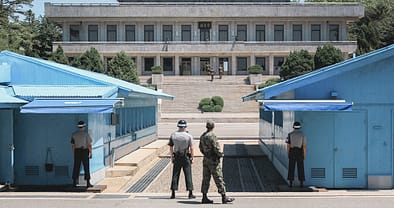
JSA Panmunjom & DMZ Guided Tour
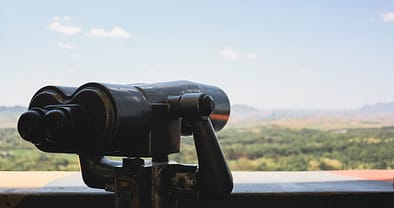
DMZ Guided Tour

Incheon Airport Transfers
- Combined Tour(JSA & 3Tunnel)
Panmunjeom(Joint Security Area) Tour
- DMZ&3Tunnel Tour
- DMZ #3 Tunnel & Provance Cafe Village
- About Location
Combined Tour(JSA & 3Tunnel)
Korean Demilitarized Zone (DMZ) and Joint Security Area (JSA) tour from Seoul
See the demarcation of North Korea and South Korea at the infamous border with an expert guide
Visit Imjingak Park, the Freedom Bridge, the 3rd Infiltration Tunnel and the DMZ exhibition hall
Stop by the JSA’s Freedom House and learn about Bridge of No Return near Panmunjom
Have lunch at a Korean restaurant
Transport by comfortable coach included
Seoul day trip to the Joint Security Area near Korea’s north-south border
Visit the War Memorial of Korea in Yongsan and gaze at multiple monuments at Unification Park
Tour the JSA with a knowledgeable guide and learn about talks between both Koreas
Hear about the tragic events that took place at the Bridge of No Return
DMZ&3Tunnel Tour
Korean Demilitarized Zone (DMZ) tour from Seoul
Explore the front lines of the North Korea-South Korea border with your expert guide Discover the symbol of this zone, representing both division and unification
Observe North Korea through binoculars atop the Dora Observatory
Learn about the tumultuous history of the country as you visit Imjingak Park, the Freedom Bridge, the 3rd Infiltration Tunnel and the DMZ exhibition hall
Thank you for visiting our company But we don’t currently proceed with the DMZ program. Have a nice day!
感谢您访问我们公司 但我们目前没有继续进行 DMZ 计划。 祝你今天过得愉快!
当社をご覧いただきありがとうございます しかし、私たちは現在、 DMZ計画を進めていません。 良い1日を!

DMZ Tour: How to Travel to the Border of North Korea & Inside the JSA
- Now Week Month
DMZ Tour: How to Travel to the Joint Security Area of South Korea
By far, one of the most fascinating places I’ve ever been to is the Panmunjom Joint Security Area located inside the DMZ at the border of North and South Korea. In fact, this is one of the most unique places in the world. I highly recommend a DMZ tour.
Joint Security Area Korea: What Exactly is the JSA and What is Its Purpose?
In essence, the JSA or Joint Security Area exists within the Demilitarized Zone (DMZ) to act as a buffer between North and South Korea along the 38th Parallel. Within this zone, the JSA acts as a meeting point between both sides. The JSA is the location where all negotiations since 1953 have occurred. It’s here you will find ROK soldiers standing in a face to face détente with North Korean soldiers.
By far, one of the most fascinating places I’ve ever been to is the Panmunjom Joint Security Area located inside the DMZ at the border of North and South Korea. In fact, this is one of the most unique tours in the entire world.
The JSA is the location where all negotiations since 1953 have occurred. It’s here you will find ROK soldiers standing in a face to face détente with North Korean soldiers.
To get to the JSA you will need a military escort to take you there as opposed to just visiting the DMZ.
Panmunjom and the Joint Security Area are often used interchangeably, but Panmunjom is actually an abandoned village just north of the de facto border of North and South Korea where the 1953 Korean Armistice Agreement was signed. Today, none of this village actually remains.
After the 1953 agreement, the Joint Security Area was constructed to house talks between the United Nations Command (UNC) and both the North Koreans and their regional ideological ally, China.

I spent a lot of time in South Korea over the course of a couple of years so my first visit to the border was to the DMZ. I returned again to visit the JSA.

On my last trip to South Korea, I went to the border alone. After booking arrangements this time a week early, I got on a bus one morning and rode an hour’s drive to the border down Unification Road.
I found myself sitting next to a rugged Army vet who spoke little but managed to inform me that the bracelet on his wrist is worn out of respect for the friends he lost on 9/11. He was there at the World Trade Center.
The bus ride was quiet and I remember everyone silently gazing out over the heavily armed border, out into North Korea. Once we left Seoul, the tone shifted.
A Panmunjom tour, however, isn’t without its risks. This is the most heavily armed border in the world and tensions between North and South Korea are always simmering. There are always joint military exercises between the US and South Korea and without fail North Korea threatens action in protest.

Was I nervous about visiting? A little. The agreement in 1953 is a ceasefire agreement which just means the two countries are still technically at war, as seen by previous incidents in history that have broken out.
When you visit the JSA, you are first taken to Camp Bonifas base camp where you’re given a briefing in Ballinger Hall. It’s here you are handed a Visitor Declaration to sign. Camp Bonifas was last attacked by the North Koreans on August 29, 1967, which killed one US and two ROK soldiers and wounded 24 others. Upon entering the camp, you’re told to stop filming or recording anything.
Sometimes it’s easy to have a false sense of security when you travel, but you are required to sign this form acknowledging that you’re entering a war zone and death is possible.

As we headed into the JSA, we were cautioned not to make any gestures or eye contact with any of the North Korean guards as they often try to create attention. They told us they often try to distract ROK soldiers and make funny faces outside of their windows. They referred to one of their buildings as the monkey house for that reason.

If you look in the center of the photograph above, you can see a ridge on the ground. This is the Military Demarcation Line (MDL) defining North and South Korean territory around the 38th Parallel. Also, below, a closer photo of the MDL taken from inside the UN Command Military Armistice building.

DMZ Tours at the South Korean Border
There are many tours available, here are a few of my recommendations. Again, you’ll need to book in advance to ensure proper background and passport checks.


1. DMZ Tours & JSA Tours via Viator
There are some VERY interesting tours available. Personally, I wish I could have taken a tour with North Korean Defectors! But these are great options and Viator is super easy to book.
Book a JSA & DMZ Tour $127
Book a tour with north korean defectors $105, book a dmz & panmunjom tour $134.90, book a full day dmz & panmunjom $135, facts to know before your jsa tour.

Panmunjeom Facts
The Bridge of No Return is the spot where all POWs were repatriated after the end of the war.
DMZ Tour Political Videos
Secretary of state hillary clinton visits the jsa, north korean soldier in jsa rants about us imperialism , in essence…a dmz tour is unforgettable.
I totally recommend a visit and a DMZ Tour. It will open your eyes to the reality of a conflict that we hear about 24/7. It’s one thing to hear about the North and South Korean conflict, but it’s another to witness for yourself the reality of these delicate tensions on the ground. It’s indescribable. Plus, you can actually say you’ve stepped foot in North Korea.
Search Hotel Deals in Seoul
What's your reaction.

How to Use Gua Sha | Romee Strijd’s Natural Face Life Routine

5 Biotin & Collagen Supplements Worth a Try
I regret never going the JSA route for sure, Stephanie. Went to two different parts of the DMZ (Dorasan, Goseong) and wish we’d gotten to go here. The time we went to Dorasan, etc. was way more uptight than Goseong on the East Coast.
I really liked your story of the army man sitting next to you and the fact he mentioned his ribbon. Too bad he lost his friends and hopefully he’s coping with that as well as possible.
Thanks for sharing this, Stephanie. I miss Korea more and more everyday. Btw, did you also live there or just visit from Japan?
Ah, I wish you got to go! But now it’s another excuse as to why you have to go back:).
We lived in Japan, but my husband had to work in Korea for about three months so I went to live with him for a lot of it. We were in Busan and Seoul. I loved Korea, I wish I could have explored more of its beautiful country.
Leave a Reply Cancel reply
Your email address will not be published.
Yes, add me to your mailing list.
This site uses Akismet to reduce spam. Learn how your comment data is processed .
Getting Spooked by Alcatraz at Night: My Alcatraz Night Tour Review

© 2024 The Passport Lifestyle. All Rights Reserved. Disclaimer and Privacy Policy .
Turn your travel photos into cherished memories with our Lightroom Presets!

How to Visit the DMZ and JSA from Seoul
There may be some affiliate links on this page, which means when you click we get a small percentage of the purchase at no extra cost to you. This allows us to keep this page running. Enjoy!
Last Updated on April 13, 2023 by Sarah Puckett
Planning a vacation to North Korea? Yeah, I didn’t think so. But if you are visiting very-vacation-destination-worthy South Korea, you will have a unique opportunity to get a glimpse into both North Korea and its tense relations with their southern neighbor. When visiting South Korea, one of the most fascinating things you can do is take a day trip outside of Seoul to visit the Demilitarized Zone (DMZ) and Joint Security Area (JSA) , where North and South Korea meet to discuss all matters (including peace talks). This area is heavily guarded by military from both North and South Korea, and, for whatever reason, they´ve agreed to let curious foreigners visit on highly-regulated tours from Seoul.
Here’s what you’ll find in this comprehensive guide on how to visit the DMZ and JSA from Seoul :
Table of Contents
Why Visit the DMZ and JSA
- You will learn an important part of 20th-century world history which continues to have significant global impacts on international affairs today.
- For many visitors, this is as close as you may ever get to North Korea unless things change dramatically.
- It’s safer than you think.
- It’s unlike any other “tourism” experience on earth.

How to Book Your Visit to the DMZ and JSA
In order to visit the Demilitarized Zone and Joint Security Area, you must book with a package day tour departing from Seoul. This must be booked several days in advance, and you must send the tour company a photo of your passport photo page in order for them to gain clearance for you to visit the DMZ and JSA.
We went with a combined DMZ and JSA tour , which we booked using Chase Ultimate Rewards points. Otherwise, it´s $144 per person. This price is fairly standard for the combined DMZ and JSA tour.
Be aware when you book your tour that not all of them include a visit to the JSA! Some are DMZ-only tours. These are substantially cheaper, but you´ll miss the opportunity to step into North Korea and visit the conference room where talks are held between the two countries. Make sure you double check before booking whether your tour includes a visit to both the DMZ and JSA.
NOTE: We visited South Korea in 2018. With ever-changing world events, the DMZ and/or JSA may be closed to visitors at any time.
Preparing for Your Visit
IMPORTANT! You must have your passport on the day of the tour.
When visiting the JSA, you cannot carry anything off the bus – bags must be left behind. You can carry a camera or phone in your pocket.
Tim and I visited in January 2018, when it is extremely cold. If visiting in winter, wear layers and prepare for harsh conditions. If visiting in summer, prepare for exactly the opposite – hot and humid conditions. Be mindful of the dress code regardless of the season. When in doubt, wear long pants, clean shoes, and a long sleeve shirt (or carry a sweater or jacket you can put over a sleeveless shirt).
What to Expect on Your Tour
You´ll meet at the location designated by your tour operator. For us, this was at Yongsan Station in Seoul. If you are staying in a hotel in Seoul, they will pick you up there.
- The tour operator will drive you to the Demilitarized Zone starting point. Here you will see the Peace Bell and an amusement park (which is quite odd at the most heavily militarized area on earth).
- Dorasan Station, which used to have a train operating between north and south, but now only operates in one direction.
- The Third Infiltration Tunnel, which North Korean troops made using dynamite in the 1970s in order to enter South Korea in a coordinated attack from under ground. You will get to go into this tunnel.
- The Dora Observation Deck, where, from a distance, you will be able to see cities and towns, including the fake “propaganda village” of North Korea.
- After these sights, you will have lunch which will most likely be included in your tour.

- After lunch, you will visit the Joint Security Area , where you will be escorted by a member of the United States Military into an auditorium where you must sign a statement acknowledging you are going into a hostile territory where death or injury can result directly from enemy action. Following a briefing, you will proceed in military formation to the JSA. You must follow military commands at all times, as you will be under constant watch from North Korean soldiers from watch towers and windows. You will go into a conference room used for talks between the two sides and you will have the opportunity to stand in North Korea. Do not touch anything or say anything that could get you in trouble, as the room has microphones that are monitored 24/7 by North Korea. The US soldier will speak about this room. You will be allowed to take photos. Note you will be asked to show your passport numerous times during this portion of the tour.
- After visiting the JSA you will transfer via bus (provided by tour operator) back to Seoul. Our operator dropped us off at the Seoul City Hall metro station and we took the subway to our apartment from there.

Is Visiting the DMZ and JSA Right for You?
Visiting the DMZ and JSA means you are visiting one of the most hostile areas on earth. There is heavy military presence from the United States of America, South Korea and North Korea. The Korean War is still ongoing (they are merely in an armistice), and North Korea has violated the terms of the armistice numerous times. A breach of this armistice could occur at any time and you could be hurt or killed if this takes place during your visit. Visiting this area is not for the faint of heart. Additionally, I would not recommend it for children or anyone who has a hard time following instructions. It’s also worth noting that tours can be cancelled at any time at the discretion of the military.
Additional Tips for Visiting the DMZ and JSA
- Check out my comprehensive one week itinerary for Seoul .
- Hear me and other experts discuss what it’s like to travel to South Korea in the World Nomad’s podcast!
Have you visited the DMZ or JSA already? What additional advice would you give to those planning a trip? I’d love to hear from you! Drop me a note in the comments, or feel free to contact me!

Similar Posts

Tongariro Crossing Hike – Guide to NZ’s Best Day Trek

Guide to Mount Pinatubo Hike from Manila

Komodo Boat Trip – Complete Guide

10 Day Japan Itinerary

Cape Reinga Day Tour Itinerary and Best Things to Do

Snorkeling with Manta Rays and Whale Sharks in Australia’s Ningaloo Reef
This was super informative. Will have to add it to my list, it’s nice to know what to expect!
Hey Meranda, thanks for reading! I’m glad you found it helpful – do you have a trip planned there?
Hi there! Can you recommend specific tours that include the JSA visit? Most seem just to include the DMZ.
Hi Bea! We booked this one: https://www.viator.com/tours/Seoul/Korean-Demilitarized-Zone-DMZ-and-JSA-Panmunjom-Tour-from-Seoul/d973-5754ICNDMZJSA , but appears it is not bookable currently. When we visited they did say that JSA may be excluded from tours if there are certain political or military issues at hand. It’s possible tensions between north and south and/or covid may be the reason.
Leave a Reply Cancel reply
Your email address will not be published. Required fields are marked *
Save my name, email, and website in this browser for the next time I comment.
This site uses Akismet to reduce spam. Learn how your comment data is processed .
- International edition
- Australia edition
- Europe edition

Explainer: What is the Joint Security Area between North and South Korea?
A US soldier who has been detained in North Korea reportedly entered the country during a tour of the JSA
- US soldier detained by North Korea after crossing border during visit to DMZ
A US soldier was detained by North Korea on Tuesday after he crossed into the country “wilfully and without authorisation”, according to a US official.
The soldier, Private 2nd Class Travis King, crossed the military demarcation line that separates the two countries while on a tour of the Joint Security Area (JSA) between North and South Korea . He is the first American detained in North Korea in five years.
What is the Joint Security Area?
Also known as Panmunjom or the “peace” or “truce” village, the JSA is a section on the 250km-long Demilitarized Zone separating North and South Korea.
In 1948, when the Democratic People’s Republic of Korea (North Korea) and the Republic of Korea (South Korea) were created, the DMZ marked the border between the two countries. In 1950, North Korea invaded South Korea, starting the Korean war, which ended in an armistice in 1953, signed at the JSA, at which point the DMZ became a 2km-wide buffer zone. The DMZ is lined on both sides with razor wire, heavy armaments and tank traps.
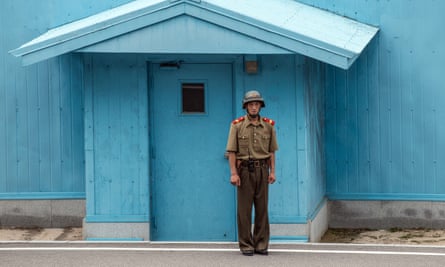
The peace village is made up of bright United Nations-blue buildings, bisected by a military demarcation line. The two Koreas have their own liaison offices and conference halls in the JSA and troops from each country face each other across the military demarcation line, but despite working in close quarters, communication is often strained.
During periods of high tensions phone hotlines often go unanswered, forcing US or South Korean officials to try to shout across the border.
For years, both sides also blared propaganda broadcasts over the DMZ into each other’s territory. The broadcasts ended after a 2018 military agreement.
The JSA is overseen by North Korea and the UN Command, a multinational military force established during the Korean war.
In 2018, North Korean leader Kim Jong-un and South Korean president Moon Jae-in met on the north and south sides of Panmunjom . In 2019, US president Donald Trump became the first incumbent president to enter North Korea, when he travelled to the JSA, crossed the military demarcation line on foot and shook hands with Kim .

Can you visit the JSA?
Under a 1953 deal, the UN Command and the North Korean military were allowed to send no more than 35 troops to the JSA, and each of them can only possess one pistol or non-automatic rifle. But the number of soldiers and weapons increased as relations worsened. No civilians live in the JSA.
Vast stretches of the DMZ have been no man’s land for more than 60 years, where wildlife has flourished undisturbed. Other parts of it offer an unsettling mix of military installations and tourist attractions.
Multiple companies offer tourists visiting South Korea the chance to visit the JSA. Lonely Planet describes it as “unquestionably the highlight of any trip to the DMZ” during which, “You’ll be taken inside the meeting room – where the 1953 truce was signed – the only place where you can safely walk into North Korea”.
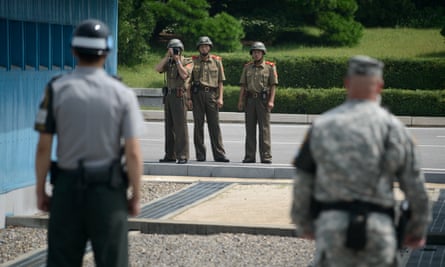
It was while on one of these tours that US soldier Travis King crossed the border. The Donga and Chosun Ilbo newspapers cited South Korean army sources who claimed the man was with a group of visitors, including civilians, to the Panmunjom truce village “when he suddenly bolted over the brick line marking the border”.
The DMZ is littered with landmines planted over the decades, as many as 970,000 in the southern part alone, according to Landmine and Cluster Munition Monitor, a Geneva-based civic group.
Why did the US soldier cross the military demarcation line?
That remains unclear. King had served nearly two months in a South Korean prison for assault. He was released and was meant to travel home to Fort Bliss, Texas, where he faced further disciplinary action. After being escorted to the airport, he left and joined a tour to the JSA.
The US is working with North Korea to “resolve this incident”, said White House press secretary Karine Jean-Pierre. The detention comes amid heightened tensions between the US and North Korea over Pyongyang’s increasing nuclear capabilities.
Reuters contributed to this report
- North Korea
- South Korea
- Asia Pacific
- US foreign policy
- US military
Most viewed
- Skip to main content
Trazy - Book Travel Crazy Things to do in Asia
Dmz and jsa 1 day tour, how to book.
- Destination
Experience Carousel
Experience basic information, basic information, coupons & promos.

Meet Location
- City Hall Station (Line 2) Exit 5
- Round-trip transportation
- English speaking tour guide
- Entrance fee
Check out Photo reviews

Cancellation policy
실시간 주요 뉴스 PUSH 알림서비스를 구독할 수 있습니다.

korea joongAng daily
Home > national > north korea.

Special tours to iconic JSA set to resume after four-month suspension
![joint security area tour korea Panmunjom, Joint Security Area of the Demilitarized Zone [YONHAP]](https://koreajoongangdaily.joins.com/data/photo/2023/11/21/0984791a-4933-494a-9532-290d0ffc0dc8.jpg)
Panmunjom, Joint Security Area of the Demilitarized Zone [YONHAP]

More in North Korea
China's top legislator Zhao meets senior North Korean politician to strengthen bilateral ties
South Korea seizes ship suspected of violating sanctions on North
North Korea declares missile system complete
South Korea, U.S. to practice crippling North's nuclear command
North launches intermediate-range ballistic missile into East Sea
Related Stories
DMZ tours, suspended for more than a year, to resume
Virtual DMZ tours go live in Paju
North brings its loudspeakers back to the border
South Korean soldier mistakenly fires machine gun near inter-Korean border
North Korean defector was pro gymnast, cleared 3-meter fences to cross DMZ
You might also like

To write comments, please log in to one of the accounts.
Standards Board Policy (0/250자)

Where the Two Koreas Meet
By John Yoon and Chang W. Lee July 19, 2023
- Share full article

A U.S. soldier crossed into North Korea at the border with South Korea at the Joint Security Area.
Here’s what the compound is like →
The Joint Security Area, also known as Panmunjom, was created as part of the 1953 armistice that halted the Korean War. Both sides have troops stationed there. Conference buildings straddle the border.
A journalist on a recent tour stood in one such building with a foot in each Korea, as a South Korean soldier stood watch at the door. Outside, the border was demarcated by a concrete slab that visitors weren’t allowed to cross.
Panmunjom is in the demilitarized zone, or DMZ, a 2.5-mile-wide strip of land that’s strewn with mines and lined with barbed wire. The DMZ is a buffer between the Koreas, which technically are still at war.
A short walk from Panmunjom’s buildings is a hill, from which visitors can see a North Korean town called Kijong. Each Korea built a village within the DMZ, for propaganda purposes, after the 1953 armistice; Kijong is the North’s.
Panmunjom is suffused with history. On the side of one building, there were still bullet holes from Nov. 13, 2017, when North Korean troops fired on a fellow soldier as he fled to the South through the compound.
The soldier, Oh Cheong-seong, was shot five times but made it across the border, in one of the most dramatic and dangerous flights from the North since the armistice. He is now a South Korean citizen.
Wherever they went, visitors were watched by soldiers from the South and the United States. (The Americans are there under the auspices of the multinational United Nations Command.) The soldiers were unarmed, abiding by a 2018 agreement between the Koreas.
No soldiers from North Korea could be seen. But visitors were told they sometimes peeked out from Panmungak, a three-story North Korean building across the border.
A memorial for fallen soldiers from the Korean War stood on the nearby hill. The monument, installed next to a military observation tower, also expressed hope for the reunification of the two Koreas.
“We promise for eternal prosperity and peaceful unification in the Korean Peninsula,” it read.
Read more about North and South Korea:

Advertisement
Official websites use .gov
Secure .gov websites use HTTPS
Joint Press Statement for the 24th Korea-U.S. Integrated Defense Dialogue
The U.S. Department of Defense (DoD) and the Republic of Korea (ROK) Ministry of National Defense (MND) held the 24th Korea-U.S. Integrated Defense Dialogue (KIDD) on April 11, 2024 in Washington.
Assistant Secretary of Defense (ASD) for Indo-Pacific Security Affairs, Dr. Ely Ratner, and Acting Deputy Assistant Secretary of Defense (DASD) for East Asia, Mr. Andrew Winternitz, led the U.S. delegation. Deputy Minister (DEPMIN) for National Defense Policy, Mr. Cho Chang-rae, led the ROK delegation. Key senior U.S. and ROK defense and foreign affairs officials also participated in the dialogue.
In a plenary session, both sides had an in-depth discussion focusing on the three key pillars of the 'Defense Vision of the U.S.-ROK Alliance' agreed to by the ROK and the United States at the 55th Security Consultative Meeting (SCM): enhancing extended deterrence efforts against the Democratic People's Republic of Korea (DPRK), modernizing Alliance capabilities by evolving into a science and technology alliance, and strengthening solidarity and regional security cooperation with like-minded partners. Both sides agreed the KIDD was the primary forum to review and report on implementation of specific tasks in accordance with the Defense Vision of the U.S.-ROK Alliance to the SCM. They committed to continue assessing ways to synchronize and align U.S.-ROK bilateral defense mechanisms and engagements to effectively and efficiently support discussions on strengthening the U.S.-ROK Alliance and the combined defense posture.
First of all, the two sides expressed concerns that the DPRK's continued provocations and advancing nuclear and missile capabilities are destabilizing the Korean Peninsula and the region, and shared their assessments of the security environment. Both sides committed to demonstrating the strength of the Alliance through close and coordinated bilateral responses to DPRK provocations, threats, and activities that undermine regional peace and stability.
In that vein, the U.S. side affirmed its ironclad commitment to extended deterrence through regularly visible U.S. strategic asset deployments, and to support the establishment of the ROK Strategic Command to enhance deterrence against the DPRK nuclear and missile threats.
In addition, the U.S. side reaffirmed its enduring and ironclad commitment to the defense of the ROK, leveraging the full range of U.S. military capabilities — including nuclear, conventional, missile defense, and advanced non-nuclear capabilities — and reiterated that any nuclear attack by the DPRK against the United States or its Allies and partners is unacceptable and will result in the end of the Kim regime. The two delegations discussed the DPRK's expanding military cooperation with Russia, which violates United Nations Security Council Resolutions (UNSCRs). Both agreed that expanded DPRK-Russian military cooperation, particularly the transfer of weapons and high-technology, undermined peace and stability in both Europe and the Indo-Pacific region including the Korean Peninsula and pledged to respond in a close coordination with the international community. The two sides also acknowledged the importance of full implementation of UNSCRs by the entire international community, including Russia and other members of the Security Council, and reaffirmed that these efforts supported the denuclearization of the DPRK.
Both sides assessed that the recent FREEDOM SHIELD exercise 24 (FS 24), which applied a new concept of operations, enhanced the Alliance's crisis management, and strengthened deterrence and defense against advancing DPRK threats. In addition, the two sides affirmed the plan to execute a TTX reflecting a DPRK nuclear use scenario, consistent with the Washington Declaration and as agreed by the Nuclear Consultative Group (NCG), and pledged that U.S.-ROK combined exercises would stay responsive to the rapidly changing security environment on the Korean Peninsula. They also agreed that it was imperative for the Alliance to conduct practical combined exercises and trainings, and acknowledged the need to improve realistic training conditions for U.S. and South Korean troops, including through the joint use of ROK facilities and airspace for mutually-agreed training.
The two sides agreed to further modernize Alliance capabilities by leveraging their science and technology to bring cutting-edge technologies to the warfighter, in accordance with the Defense Vision of the U.S.-ROK Alliance. They commended the accomplishments of the Cyber Cooperation Working Group (CCWG) including the U.S.-ROK Cyber Alliance exercise in January 2024. In addition, both sides noted that the ROK's recently launched military reconnaissance satellite is an important asset and contribution to extending the U.S.-ROK combined capabilities for surveillance and reconnaissance. The two sides pledged to continue cooperation through the Space Cooperation Working Group (SCWG) to strengthen the Alliance's space capabilities. In addition, both sides urged the working groups to focus on initiatives to enhance mission assurance and resilience against evolving threats. The leaders agreed that science and technology (S&T) cooperation needs to be strengthened in areas such as artificial intelligence, autonomous technology and next-generation communications, and that fields of S&T cooperation should contribute to Alliance policy established by the SCM. In that vein, the two sides discussed the way forward to establish a ROK-U.S. senior-level committee to enable science and technology cooperation and reviewed a ROK proposal to organize a U.S.-ROK joint defense science and technology conference.
The two sides agreed that cooperation to develop advanced technologies also supports shared efforts to enhance the defense industrial base of both the United States and ROK, respectively. The two delegations had an in-depth discussion on the Defense Department's progress to develop a Regional Sustainment Framework to facilitate logistics in a contested environment as well as cooperation to distribute Maintenance, Repair, and Overhaul capabilities in the Indo-Pacific. The U.S. side noted the ROK's efforts to collaborate on MRO initiatives, and affirmed that such cooperation is in accordance with the direction of enhancing the Alliance's posture and capabilities. The two leaders also agreed to enhance progress on development of a Reciprocal Defense Procurement Agreement to provide reciprocal market access, which will enhance supply chain resiliency and strengthen defense cooperation between the United States and the ROK.
The two sides reaffirmed the long-standing contribution made by the United Nations Command (UNC) to peace and stability on the Korean Peninsula, and committed to strengthening UNC. Both sides appreciated that the results of the ROK-UNC Member States Defense Ministerial Meeting held in Seoul in November 2023 demonstrated the commitment and resolve of UNC Member States to implement, manage, and enforce the observation of the Armistice Agreement and to be united upon any renewal of hostilities or armed attack on the Korean Peninsula. The U.S. side expressed its appreciation for ROK's efforts to continue strengthening cooperation between the ROK, UNC, and UNC Member States by regularizing meetings, and both sides agreed to work closely together.
The KIDD delegations applauded the efforts of the Conditions-based Operational Control (OPCON) Transition Working Group, noting progress towards the transition of wartime OPCON to the Future Combined Forces Command. In particular, the two sides reviewed the progress on this year's bilateral evaluation on the capabilities and systems, and exchanged views on OPCON issues including the transition of Combined Component Commands to standing component commands. In addition, the two leaders reaffirmed their shared commitment to meeting the three conditions under the bilaterally approved Conditions-based OPCON Transition Plan (COTP) in a systematic and stable manner to strengthen the Alliance combined defense capabilities.
During an Executive Session, ASD Ratner and DEPMIN Cho emphasized the important contribution of the Tailored Deterrence Strategy to deter and respond to advancing DPRK nuclear and missile threats, and welcomed the ongoing efforts of the NCG that contribute to this effect. DEPMIN Cho stressed the importance of ROK-U.S. integrated extended deterrence to the combined posture. The two leaders agreed that the consultation process enabled by the SCM provides the necessary oversight and guidance for combined plans and operations executed in defense of the Alliance.
The two leaders also stressed the importance of trilateral cooperation with Japan, and reviewed the unprecedented progress achieved since the historic Camp David Summit. The U.S. and ROK leaders shared the view that trilateral cooperation with Japan is critical to achieve shared security goals on the Korean Peninsula and in the Indo-Pacific region. Both sides welcomed the successful activation of a three-way data sharing mechanism for early missile warning information against DPRK threats, as well as the regularization of trilateral exercises. The two sides pledged to work through the Defense Trilateral Talks to deepen cooperation in response to the regional security environment, with a focus on operations in various domains.
The U.S. and ROK sides also reviewed the development of the Alliance into a globally comprehensive strategic relationship grounded in shared values and interests. Both sides concurred that it is important to make joint efforts to promote defense and security cooperation in the region. In that vein, reviewing progress from the Regional Cooperation Working Group, the two sides agreed to continue pursuit of security cooperation initiatives that promote regional peace and stability. In addition, both sides concurred on the importance of preserving peace and stability in the Taiwan Strait as reflected in the April 2023 “Joint Statement in Commemoration of the 70th Anniversary of the Alliance between the United States of America and the Republic of Korea.”
ASD Ratner and DEPMIN Cho agreed that the 24th KIDD provided guidance to continue deep and transformative Alliance cooperation in support of our shared values and interests. In particular, both sides assessed that the KIDD laid a foundation for a practical implementation of the Defense Vision of the U.S.-ROK Alliance and emphasized the Alliance's decisive and overwhelming combined defense posture. The two leaders commended the U.S. and ROK military and civilian personnel that worked to strengthen the bond of the Alliance, and expressed appreciation for their shared commitment and sacrifice.
Subscribe to Defense.gov Products
Choose which Defense.gov products you want delivered to your inbox.
Defense.gov
Helpful links.
- Live Events
- Today in DOD
- For the Media
- DOD Resources
- DOD Social Media Policy
- Help Center
- DOD / Military Websites
- Agency Financial Report
- Value of Service
- Taking Care of Our People
- FY 2025 Defense Budget
- National Defense Strategy
The Department of Defense provides the military forces needed to deter war and ensure our nation's security.
- Today's news
- Reviews and deals
- Climate change
- 2024 election
- Fall allergies
- Health news
- Mental health
- Sexual health
- Family health
- So mini ways
- Unapologetically
- Buying guides
Entertainment
- How to Watch
- My watchlist
- Stock market
- Biden economy
- Personal finance
- Stocks: most active
- Stocks: gainers
- Stocks: losers
- Trending tickers
- World indices
- US Treasury bonds
- Top mutual funds
- Highest open interest
- Highest implied volatility
- Currency converter
- Basic materials
- Communication services
- Consumer cyclical
- Consumer defensive
- Financial services
- Industrials
- Real estate
- Mutual funds
- Credit cards
- Credit card rates
- Balance transfer credit cards
- Business credit cards
- Cash back credit cards
- Rewards credit cards
- Travel credit cards
- Checking accounts
- Online checking accounts
- High-yield savings accounts
- Money market accounts
- Personal loans
- Student loans
- Car insurance
- Home buying
- Options pit
- Investment ideas
- Research reports
- Fantasy football
- Pro Pick 'Em
- College Pick 'Em
- Fantasy baseball
- Fantasy hockey
- Fantasy basketball
- Download the app
- Daily fantasy
- Scores and schedules
- GameChannel
- World Baseball Classic
- Premier League
- CONCACAF League
- Champions League
- Motorsports
- Horse racing
- Newsletters
New on Yahoo
- Privacy Dashboard
US-South Korea joint air force exercises kick off near Seoul
The United States and South Korea launched large-scale air force exercises involving around 100 combat aircraft of various types, the South Korean news agency Yonhap reported on April 12.
The two-week Korea Flying Training (KFT) got underway at Kunsan Air Base in Gunsan, 178 kilometers south of Seoul, with plans to mobilize around 25 types of aircraft, including U.S. F-35B and South Korean F-35A stealth fighters, the publication said.
The exercise, which will also involve U.S. Army and Marine Corps personnel, focuses on integrating advanced fighter jet operations, enhancing precision strike capabilities, and training troops on combat search and rescue scenarios and mass paratrooper airdrops, the article said.
These exercises gain additional significance against the backdrop of ongoing provocations from North Korea, which recently conducted a test of a solid-fuel intermediate-range ballistic missile, purportedly equipped with a hypersonic warhead, on April 2. The drills signify a robust response to the persistent threats in the region, demonstrating the U.S. and South Korea's resolve to maintain stability and deter aggression.
Seoul reports Pyongyang gunning its weapon factories to max output, supplementing Russian stockpiles
North Korea keeps supplying Russia with weapons – Pentagon
Seoul seizes cargo ship sailing from North Korea to Russia — report
We’re bringing the voice of Ukraine to the world. Support us with a one-time donation, or become a Patron !
Read the original article on The New Voice of Ukraine
Recommended Stories
Republicans () are killing a tax cut.
In a flip of the usual priorities, Senate Republicans seem likely to kill a set of tax cuts that have already passed the House and are broadly popular. Here's why.
US economy has Wall Street 'borderline speechless' after blowout March jobs report
The March jobs report was the latest piece of economic data to surprise Wall Street analysts and send stocks rallying.
Trump legal news brief: Judge hands Trump another defeat, blocking ‘fishing expedition’ subpoena to NBC over Stormy Daniels documentary
Judge Juan Merchan blocks an attempt by former President Donald Trump to force NBCUniversal to hand over information about the release of its recent documentary about adult film star Stormy Daniels.
How strong is the hush money case against Donald Trump?
The heart of the Manhattan DA's indictment relies heavily on an untested legal theory that some experts say will be very hard to prove.
Starlink terminals are reportedly being used by Russian forces in Ukraine
Starlink internet terminals are reportedly being widely used in Ukraine by Russian forces. There’s a thriving black market for the devices which stretches beyond Ukraine into Sudan.
Jay Powell really wants Americans to know he is not thinking about politics
The Fed chairman went out of his way to make it clear this week that the Fed is free from personal or political bias as he continues to navigate a red-hot political year.
Haiti prepares for a transition of power as deadly violence escalates
Haiti is preparing for a transition of power, with the help of the U.S., after weeks of the country being overrun by deadly gang violence.
The FCC will vote to restore net neutrality later this month
The Federal Communications Commission (FCC) plans to vote to restore net neutrality later this month. With the Democrats finally holding an FCC majority in the final year of President Biden’s first term.
Trump’s shifting abortion stance, Jonathan Majors sentenced to counseling and scenes from the 2024 solar eclipse
The stories you need to start your day: GOP leaders condemn Trump’s abortion stance, UConn’s NCAA victory and more in today’s edition of The Yodel newsletter
All eyes on the Federal Reserve: What to know this week
An update on the Federal Reserve's plans for interest rates will challenge the market rally in the week ahead.
Why China's options in response to a TikTok ban are limited
China risks alienating much-needed foreign investment should it hit back against the US over a potential ban on TikTok, its social media success story.
Trump's 1st criminal trial begins Monday. Here's what you need to know.
On Monday, Donald Trump will again make history, becoming the first former president to go to trial on criminal charges.
Wizards, Capitals owner Ted Leonsis reportedly spoke with Maryland Gov. Wes Moore about arena plans
Ted Leonsis is on the hunt for a new location to house his Wizards and Capitals' venue.
Should TikTok be banned?
Concerns that the Chinese-owned app might pose a national security threat have been raised for years. Is it time to block it from operating in the U.S.?
This is the best election outcome for markets
Most people focus on the presidential frontrunners, but control of Congress matters nearly as much.
Biden and Netanyahu speak for 1st time since Israeli airstrikes killed 7 aid workers
The call comes at a time of growing U.S. disapproval of Israel’s handling of the war against Hamas.
Laken Riley's father doesn't want his daughter's death to be a political talking point. He's not alone.
Laken Riley, the Georgia student who was killed last month, allegedly by an undocumented immigrant, is the latest to be used as a political flashpoint in the fight over border security. Her father doesn't want her death to be a political talking point. He's not alone.
How Ukraine’s cyber police fights back against Russia's hackers
On February 24, 2022, Russian forces invaded Ukraine. For the Ukrainian forces who had to defend their country, for the regular citizens who had to withstand invading forces and constant shelling, and for the Cyberpolice of Ukraine, which had to shift its focus and priorities. “Our responsibility changed after the full scale war started,” said Yevhenii Panchenko, the chief of division of the Cyberpolice Department of the National Police of Ukraine, during a talk on Tuesday in New York City.
Elevated immigration to boost US economic growth, Goldman Sachs says
Economists believe an above-trend addition of immigrants to the US population could boost the labor market and overall economic growth in 2024.
How changes to an abortion pill could lead to an impact 'bigger than Dobbs'
The economic fallout from the reversal of Roe v. Wade was lessened by a surge in telemedicine. That could change depending on the outcome of another Supreme Court case this year.
Mobile Menu Overlay
The White House 1600 Pennsylvania Ave NW Washington, DC 20500
Joint Vision Statement from the Leaders of Japan, the Philippines, and the United States
Stay Connected
We'll be in touch with the latest information on how President Biden and his administration are working for the American people, as well as ways you can get involved and help our country build back better.
Opt in to send and receive text messages from President Biden.
- Entertainment
- Newsletters
US, Japan and South Korea hold drills in disputed sea as Biden hosts leaders of Japan, Philippines
Mari Yamaguchi
Associated Press
Copyright 2024 The Associated Press. All rights reserved
A F-18E fighter jet prepares to take off from USS Theodore Roosevelt aircraft carrier on Thursday April 11, 2024, during a three-day joint naval exercise by the U.S., Japanese and South Korea at the East China Sea amid tension from China and North Korea. (AP Photo/Mari Yamaguchi)
A U.S. carrier strike group led by the USS Theodore Roosevelt has held a two-day joint exercise with its allies Japan and South Korea as U.S. President Joe Biden met for talks with leaders from Japan and the Philippines at the White House . The military and diplomatic maneuvers are meant to strengthen the partners' solidarity in the face of what they see as China’s aggressive military actions in the region.
A number of U.S. and South Korean guided missile destroyers and a Japanese warship joined the drills in the disputed East China Sea, where worries about China's territorial claims are rising. The Associated Press was one of several news organizations allowed a front-row look at the drills.
Recommended Videos
Rear Adm. Christopher Alexander, commander of Carrier Strike Group Nine, said the three nations conducted undersea warfare exercises, maritime interdiction operations, search and rescue drills and work focused on communication and data sharing. He told journalists Thursday on the Roosevelt that these drills would help improve communication among the United States and its allies and "better prepare us for a crisis in the region.”
F/A-18E Super Hornet combat jets took off from the carrier’s flight deck, which also had anti-submarine MH-60R Seahawk helicopters. Journalists were flown more than an hour from Kadena Air Base, the hub of U.S. Pacific air power. Kadena is on Japan's southern island of Okinawa, which is home to about half of the 50,000 American troops stationed in Japan.
“It is a busy time; there is a lot going on in the world," Alexander said. "The significance of this exercise is we have three like-minded countries, three like-minded navies that believe in peace, security and stability in the western Pacific.”
In Beijing, the Chinese Foreign Ministry said its director-general of Asian affairs had met with a top Japanese Embassy official on Friday and expressed “serious concern and strong dissatisfaction” about Japan's “negative moves” during Prime Minister Fumio Kishida's meetings in Washington with Biden and Philippine President Ferdinand Marcos Jr.
That followed earlier Chinese statements that accused the U.S. and Japan of smearing China and urged them to stop undermining regional peace and stability, while saying China will “resolutely defend” its security and development interests.
The participation of Japan and South Korea in the joint exercise was another sign of improving ties between the sometimes wary neighbors. The two U.S. allies' relationship has often been strained by the memory of Japan's 35-year colonization of the Korean Peninsula. Washington has been pressing them to cooperate so the three partners can better deal with threats from China and North Korea.
This week's huge parliamentary election defeat of the governing party of South Korean President Yoon Suk Yeol , who has sought better relations with Japan, could constrain his Japan-friendly efforts, but experts believe ties will remain stable.
The drills focused on improving the three nations’ joint response capability against North Korea’s increasing nuclear and missile threats, South Korea’s navy said in a statement. It said the navies conducted anti-submarine exercises to enhance their readiness against North Korean submarine threats and maritime interdiction training to practice blocking potential illegal transfers of banned weapons by the North.
The latest naval exercise is part of Biden's work to deepen security and diplomatic engagement with Indo-Pacific nations. Biden invited Kishida and Marcos to the White House for their first trilateral talks Thursday, and has declared that the U.S. defense commitment to the Pacific allies is “ironclad."
Tensions between China and the Philippines have risen over repeated clashes by the two nations’ coast guard vessels in the disputed South China Sea. Chinese coast guard ships also regularly approach disputed Japanese-controlled East China Sea islands near Taiwan .
Beijing has defended its operations in the South China Sea and blamed the United States for creating tensions. Chinese President Xi Jinping had a series of talks this week with senior officials from Vietnam, Russia and Taiwan.
The U.S.-Japan-South Korea naval exercises follow four-way drills held in the South China Sea, where Japan joined the United States, Australia and the Philippines. Participants carefully avoided mentioning China and said they were holding the exercises to safeguard a peaceful and stable Indo-Pacific.
A Chinese Defense Ministry spokesperson said Friday that China's activities in the South China Sea are “justified, lawful and beyond reproach” and accused the U.S. of flexing its muscles in the region and building up anti-China cliques.
“These acts are irresponsible and extremely dangerous,” Senior Col. Wu Qian said in a statement posted online.
An area of long-simmering disputes, the South China Sea serves a key sea lane for global trade. Concerned governments include Vietnam, Malaysia, Indonesia, Brunei and Taiwan.
This story has been corrected to say that the drills took place over two days, not three.
Copyright 2024 The Associated Press. All rights reserved. This material may not be published, broadcast, rewritten or redistributed without permission.
Local 10 News Saturday @ 9AM : Apr 13, 2024
Local 10 news saturday @ 7am : apr 13, 2024, local 10 news saturday @ 6am : apr 13, 2024, local 10 news saturday @ 5:30am : apr 13, 2024, local 10 news @ 11pm : apr 12, 2024.

IMAGES
VIDEO
COMMENTS
Take Trazy Korea's Panmunjom JSA tour from Seoul and visit the borderline of South and North Korea where soldiers stand face to face in tension. This Joint Security Area tour includes round-trip transportation, lunch, tour guide, and entrance fees. ... Tour to Joint Security Area (Panmunjom) 12:20pm~1:40pm: Explore Imjingak Resort - Lunch at ...
DMZ Korea Tour Comparison Table. ... The Joint Security Area (JSA) is located in the village of Panmunjeom where the Armistice Agreement was signed and sits inside the DMZ itself. It is the location where North Korean and South Korean soldiers stand guard face to face. The JSA also has a conference room located half and half in each country ...
Panmungak's role in the Joint Security Area is to represent North Korea. The building was first constructed on September 2, 1969, and is where North Korean officials have their offices. The building also serves as the waiting room for UN officials who want to have a dialogue with North Korea.
Korean Demilitarized Zone (DMZ) and Joint Security Area (JSA) tour from Seoul. See the demarcation of North Korea and South Korea at the infamous border with an expert guide. Visit Imjingak Park, the Freedom Bridge, the 3rd Infiltration Tunnel and the DMZ exhibition hall. Stop by the JSA's Freedom House and learn about Bridge of No Return ...
Experience the intensity of the Korean Demilitarized Zone with a visit to the Joint Security Area (a.k.a. Panmunjom), connecting North Korea and South Korea. See monuments and relics of the Korean War and get to visit the infamous Third Tunnel.
The Joint Security Area (JSA) and the Demilitarized Zone (DMZ) tour offers a remarkable opportunity to explore the historical, political, and cultural complexities of the Korean Peninsula. This journey provides a deeper understanding of the ongoing division between North and South Korea while allowing visitors to witness firsthand the tension ...
Visiting the Joint Security Area (JSA) is a once-in-a-lifetime opportunity that everyone should consider. The JSA is one of the most restricted places on earth, and being able to visit it is a unique privilege. Tourists will visit the 3rd tunnel, Dora Observatory and Unification Village with our awesome tour guide By joining a JSA tour, visitors can witness firsthand the tension and history ...
Your comprehensive tour includes lunch and round-trip coach transport from Seoul. Seoul day trip to the Joint Security Area near Korea's north-south border. Tour the JSA with a guide and learn about talks between both Koreas. Hear about the tragic events that took place at the Bridge of No Return. Have lunch at a Korean restaurant in Limjin ...
Asia. The DMZ. Unquestionably the highlight of any trip to the DMZ is the Joint Security Area (JSA) at Panmunjeom. An improbable tourist destination, it's here where the infamous Military Demarcation Line separates South and North Korea. Soldiers from both sides often stand metres apart eyeballing one another from their respective sides of the ...
10:20 Briefing at Camp Bonifas. 10:30 JSA Panmunjom Tour. Tour of JSA (Joint Security Area), Peace House, Bridge of No Return, Freedom House, Axe Murder Incidents area etc. 12:20 Lunch (Bulgogi) & Imjingak Park Tour. 13:40 Leave for Seoul. 14:50 Dropoff at Hotel President or Lotte Hotel (Euljiro 1 (il)-ga) Meeting time could change.
This tour will take you to key destinations across South Korea, allowing you to delve into the country's must-see cultural attractions, bustling cities, and traditional townships. Explore museums and natural landmarks, indulge in authentic Korean cuisine, and enjoy luxurious overnight accommodations in high-end hotels. BOOK NOW.
Combined Tour (JSA & 3Tunnel) Korean Demilitarized Zone (DMZ) and Joint Security Area (JSA) tour from Seoul. See the demarcation of North Korea and South Korea at the infamous border with an expert guide. Visit Imjingak Park, the Freedom Bridge, the 3rd Infiltration Tunnel and the DMZ exhibition hall. Stop by the JSA's Freedom House and learn ...
In essence, the JSA or Joint Security Area exists within the Demilitarized Zone (DMZ) to act as a buffer between North and South Korea along the 38th Parallel. Within this zone, the JSA acts as a meeting point between both sides. The JSA is the location where all negotiations since 1953 have occurred.
When visiting South Korea, one of the most fascinating things you can do is take a day trip outside of Seoul to visit the Demilitarized Zone (DMZ) and Joint Security Area (JSA), where North and South Korea meet to discuss all matters (including peace talks). This area is heavily guarded by military from both North and South Korea, and, for ...
The Joint Security Area (JSA) is an area within the DMZ that is shared space between North and South Korea, overseen by the United Nations Command Military Armistice Commission (UNCMAC). The area includes buildings that accommodate negotiation talks and a few bridges of historical importance. DMZ View photo credit John F. Behrend (Retired USMC)
The soldier, Private 2nd Class Travis King, crossed the military demarcation line that separates the two countries while on a tour of the Joint Security Area (JSA) between North and South Korea ...
In just one day, you will get a complete insight of the North and South relations through this exclusive tour. Why this tour? Visit the main part of Demilitarized Zone (DMZ) and Joint Security Area (JSA) in 1 day. - JSA (including Panmunjom): the only area in DMZ where South and North Korean forces stand face-to-face.
Delve in to the tensions between South and North Korea on this full-day tour of the Joint Security Area (JSA), located in Panmunjom. Follow your guide to important areas such as the War Memorial of Korea, the Freedom House, the Bride of No Return, and the Unification Bride. Midday, stop for a traditional Korean lunch.
Book JSA tour for USFK members. USO Korea Official Website. The USO strengthens America's military service members by keeping them connected to family, home and country, throughout their service to the nation.
The buildings are in a small circular area known as the Joint Security Area, a patch of land within one of the largest no-man's-land on Earth, known as the demilitarized zone. The DMZ was created ...
Special tours to the iconic Joint Security Area (JSA) at the inter-Korean border will be resumed after they were suspended for four months following a U.S. soldier's attempted defection at the site in July, according to South Korea's Ministry of Unification on Tuesday.
Where the Two Koreas Meet. A U.S. soldier crossed into North Korea at the border with South Korea at the Joint Security Area. Here's what the compound is like →. The Joint Security Area, also ...
The U.S. Department of Defense (DoD) and the Republic of Korea (ROK) Ministry of National Defense (MND) held the 24th Korea-U.S. Integrated Defense Dialogue (KIDD) on April 11, 2024 in Washington.
Strengthening International Joint Research in Scientific and Technological Fields: The United States and Japan welcomed strengthening collaboration between the national research institutes and ...
The United States and South Korea launched large-scale air force exercises involving around 100 combat aircraft of various types, the South Korean news agency Yonhap reported on April 12.
We welcome the Philippines hosting an International Conference on Women, Peace, and Security in October this year, to review global implementation of the United Nations Security Council Resolution ...
A U.S. carrier strike group led by the USS Theodore Roosevelt held a three-day joint exercise with its allies Japan and South Korea, as U.S. President Joe Biden pledged an ironclad defense ...